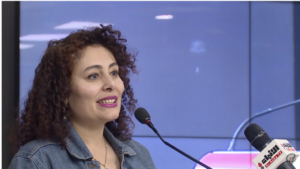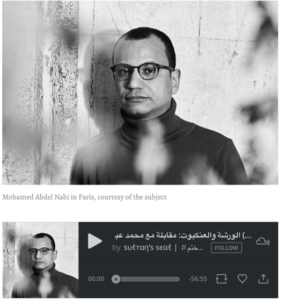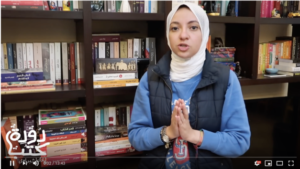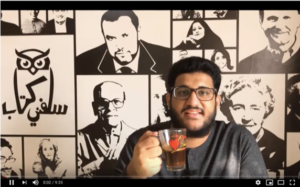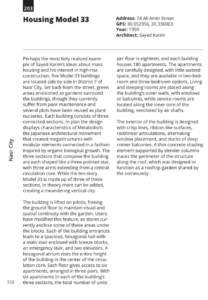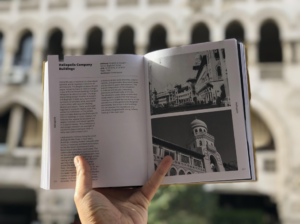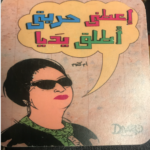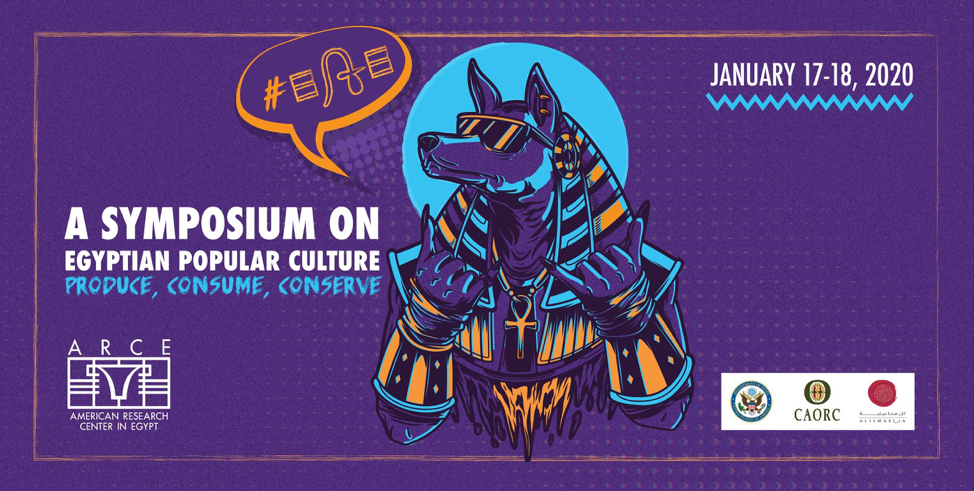
Egypt’s Podcasts and Booktubes: A Literary Criticism of the Future? | by M Lynx Qualey
Cairo Since 1900: Book Review and Interview with the Author | by Shaimaa S. Ashour
Art as Education: Street Art as a Precursor to Social Change | by Marwa Gadallah
Umm Kulthum Conquers all: Kawkab al-Sharq through Pop Art | by N. A. Mansour
Athar and the Boundless Multiplication of Relics | by Richard McGregor
The Price of Popularity | by Sally El Sabbahy

Introduction | by N.A.Mansour
Produce, Consume, Conserve: A Symposium on Egyptian Popular Culture began as a conversation in downtown Cairo at the American Research Center in Egypt (ARCE) between cultural heritage professionals and a historian about how we consume what we see when we walk around Cairo. The conversation carried on and we moved on to the problematics of presenting a city: is there something wrong with instagramming what we find charming about Cairo while cropping out the undesirable? What about enjoying the city and not being conscious of how and why we should conserve it? Then the wheels began turning: we posed the question of how that applies to books and film. We wondered why conversations like these don’t happen in more formalized settings and if in some disciplines, they don’t happen at all. So we wrote our fantasy list of who we would put in a room together if we could. We talked about how feasible such an event could be at ARCE’s Cairo location. Then we got to work: speaking to potential participants, thinking of different speaking formats, and all the other details that go into something like this. Like the event title. Produce, Consume, Conserve embodied what we wanted out of the event: to highlight how things are produced and consumed and think about how we conserve them, in whatever form that may be. We want to inspire people to conserve, but to do so responsibly.
Later came the visuals, such as the event poster. An updated Anubis drawn out in purple, gold and safflower blue, the ancient Egyptian god that looks like a jackal, it is intended to be tongue-in-cheek. There is a little bit of ARCE’s rich history in archaeological research referenced in the usage of the Anubis figure, but then there’s also the fact that pharaonic references have worked themselves into Egyptian architecture, letters, and television (see this for an interesting marriage between Egypt’s past and Oum Kulthoum). But then there’s the flipside: in some ways, the pharaonic past is not part of everyday Egyptian popular culture. Interpret the Anubis mascot for Produce Consume, Conserve as you will. I think he simply looks cool.
When we were dreaming up Produce, Consume, Conserve, we also wanted to draw in an audience that extended beyond those warm bodies we managed to draw together for the actual symposium; we wanted to cross boundaries and inspire conversations both on Egyptian popular culture itself and popular culture at large. Conversations are pleasant, but they need to have some form of export. For that reason, I present to you a digital leg of the symposium: Produce, Consume, Conserve: An Essay Roundtable on Egyptian Popular Culture, produced in collaboration with the Maydan. We’re trying to do the same thing we are doing with the symposium: striking a balance between studies of the production of popular culture, notes on how we consume popular culture, and suggestions on how we should conserve popular culture.
The roundtable begins with M Lynx Qualey. She questions what is literary criticism in Arabic in this day and age and opens our eyes to how podcasts and Booktube shape the interests of readers of Arabic literature. Shaimaa Ashour then highlights an important new publication, Cairo since 1900: An Architectural Guide, by Mohamed ElShahed; she weaves in an interview with the author himself, casting light onto the process by which such a comprehensive book was assembled. For our purposes, Ashour’s discussion of the text reminds us that architecture is consumed daily and questions how that should figure into our day-to-day lives. Marwa Gadallah then writes an accompaniment to the work of Bahia Shehab, an artist-activist-academic whose work on wall murals spans the world over. Gadallah gives us a peep into Shehab’s process and what conversations it can inspire. Then we have Ida Nitter’s contribution on Mawlid al-Nabi, the celebration of the Prophet’s birthday, one of Egypt’s most popular celebrations: she looks at the customs surrounding food and religious ceremony, as well as the history infecting it all. I have a less academic contribution: surveying a decade in pop art detailing Oum Kulthoum, Egypt’s most iconic voice. But part of the reason why we’re trying to bring people together at Produce, Consume, Conserve is to celebrate pop culture, not to demean it because it is popular but to take popular opinion as an arbiter of taste: Richard McGregor does that for us in this digital convening of PCC, with an essay on athar, prophetic relics, folded in to a heavy consideration of the lines between elite and popular culture.
We hope you enjoy this series of essays, which, we again, thank the Maydan for hosting and collaborating with us: we will be releasing them twice weekly for the next few weeks. If you’re in Cairo the weekend of January 17th and 18th, please join us at Produce, Consume, Conserve.
N.A. Mansour is a PhD candidate at Princeton University’s Department of Near Eastern Studies, where she is writing a dissertation on the transition between manuscript and print in Arabic-contexts. Her interests include Islamic studies, Arabic-language pop culture, and food.
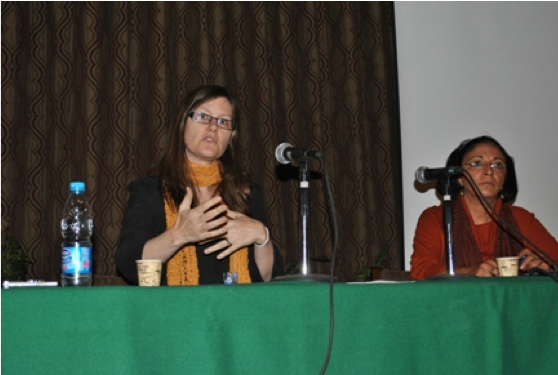
Egypt’s Podcasts and Booktubes: A Literary Criticism of the Future? | by M Lynx Qualey
In Arabic as in English, the power of the Big Critic has waned. The mid-twentieth-century Golden Age of literary criticism, with its masterful literary tastemakers based in cities central to a publishing industry, has shifted into an age of numerous critics in numerous cities around the world. Many an essay regrets the decline and fall of literary criticism and the rise of blogger-rubes such as myself. But the death of any essential human pursuit is probably greatly exaggerated: literature takes on different forms, but the drives remain the same. And while any great art may be an elite pursuit, both art and art criticism are core human instincts. What are music, stories, books, and visual art doing? Which are good? What do we mean by good? Which can be re-read, imitated, talked back to, studied?
Literary criticism has, historically, had a relatively high barrier to entry—higher than literature itself, as criticism requires the construction of authority. For most of history, gaining the support of a wealthy patron helped. More recently, access to an important literary magazine or newspaper, often with funding from a nation-state or soft-power initiative. Women were mostly outsiders, although many of the women who were effectively literary “critics” created authority by hosting a literary salon, such as the one founded by May Ziade and frequented by Taha Hussein, Abbas al-Akkad, and others, although this did not prevent family from institutionalizing Ziade.
Indeed, this was the model for ArabLit, the blog I launched in Cairo in 2009. When I gave a talk at the American University of Cairo (AUC)’s Oriental Hall in 2012, as part of the Center for Translation Studies’ lecture series, I likened ArabLit to a digital literary salon; I have credibility not by my studies or talent, but by being amid talented people. Youssef Rakha’s “Arabophile,” which morphed into the Sultan’s Seal and Cairo Cosmopolitan Hotel, is even more of a digital salon with central literary personalities who have developed along with the website.
What we lose: marginalization of criticism
Gatekeeping has its upsides, and there are reasons to weep over the ashes of the Big Critic. Writers have railed against the closed-mindedness of twentieth-century literary criticism, and for good reason; yet the best of the Big Critics also helped build a vision of literary possibility. May Telmissany, for instance, writes in a recent essay “Edwar al-Kharrat: On Books and Writing” of how the great novelist and literary critic al-Kharrat saw the scope of her career when he wrote about her first collection of short stories, before she saw it herself. Al-Kharrat also had a keen eye for seeing emergent literary trends and forms, and for drawing attention to their possibilities, and younger writers often built on his ideas.
Egyptian critic and author Mansoura Ezz Eldin, in an email interview in 2019, talked about how the influence of long-form literary criticism has waned. “Criticism has been marginalized even more with the increasing strength of social media, such that it is almost absent from the literary scene; it’s true that there are still a number of writers who are keen to continue critical writing, but it’s no longer as influential as it once was, and broader segments of the reading public are choosing what they read on the basis of literary awards and comments on social media sites, or ratings on GoodReads and other sites, and to a lesser degree by quickie reviews in literary newspapers and magazines.”
This doesn’t mean we have obviated the need for in-depth, serious literary criticism, nor that literary criticism is on the verge of extinction. It probably does mean that criticism, in Egypt as elsewhere, is going through a shaggy period of between-ness. Old forms and forums are being abandoned for any number of reasons: an association with an autocratic state; an insular, limited view of literature; or because people have lost interest in reading a particular sort of review.
The current shaggy state of criticism, as Ezz Eldin notes, opens up room for exploitation. The weakening of centralized criticism comes at a time when Gulf-led big-money prizes, fairs, workshops, and festivals are creating new pathways for literary conversation. Social media sites also build a new credibility through popularity.
There are two sorts of literary criticism. The sort that is targeted at readers, and the sort that is targeted at writers. Social media and quickie rating-based reviews absolutely have a utility in making a reader feel connected to a larger community and in control of their reading life. Yet these do not fill the same need as long-form literary criticism, which is largely targeted at the community of writers. Thus far, BookTube, or the book-focused subculture among those who post video content to YouTube, has largely fallen into the first category, while literary podcasting has largely fallen into the second.
It’s important to note that, for Arabic literature, being at the margins of “world” literature also means that other-language criticisms can have an exaggerated effect, amplifying some voices and eliding others.
What we gain: Eluding borders, reinventing form
The Arabic literary podcast is only just finding its footing as a long-form literary conversation; a literary salon that takes place in all countries at once, and to which anyone can listen in. The physical literary salon has many charms, but was sharply limited by social class, geography, and personal affinity. Printed literary conversations could be made more widely available, yet they have, in practice, faced Arabic literature’s massive distribution issues, which affect not only movement between countries, but movement within them.
Literary podcasts in all languages can get around borders, building new conversations around literature. Most podcasts are open access. There are currently only a few literature-focused podcasts in Arabic, although there are culture-focused podcasts that sometimes touch on literature. The Jordan-based Sowt network is currently looking to develop a literary podcast in Arabic, but has not yet launched one. Kerning Cultures, the work of producers across the region, sometimes focuses on literature; Egyptian BookTuber Nada Alshabrawy also recently launched a podcast focusing on international women’s writing, although it requires a subscription on the Maktabi app. Ursula Lindsey and I launched an English-language podcast about Arabic literature in the fall of 2017, called “Bulaq.” Perhaps the most important Arabic-literature podcast is the Cairo-based “Sultan’s Seal” podcast with Mina Nagy and Islam Hanish, part of Youssef Rakha’s digital salon.
The “Sultan’s Seal” podcast launched in January 2019 with a short discussion of Mohab Nasr’s poetry. The form had sufficient appeal, both for its practitioners and its audience, that it began to appear every month, mid-month, and expanded into dialogues with some of Egypt’s most prominent authors: poet-novelist Yasser Abdellatif; translator Hesham Fahmy, who brought Game of Thrones into Arabic; novelist and translator Mohamed Abdelnabi, whose In the Spider’s Room was shortlisted for the International Prize for Arabic Fiction; novelist and critic Mansoura Ezz Eldin; nonfiction author Charles Aql, the author of Coptic Cuisine; surreal short-story writer Eman Abdelrahim; novelist and short-story writer Ahmed al-Fakharani; acclaimed novelist Nael Eltoukhy; poet Emad Fouad; and, in November 2019, the first non-Egyptian guest: Algerian poet-translator Salah Badis.
New online forms have birthed new possibilities. Rakha’s digital literary salon has spawned new video and audio forms that move between conversation and criticism, the intimately personal and the broadly philosophical. Mada Masr has been another force in re-seeing the possibilities of online literary criticism, moving the focus away from the contemporary to a wider scope for Egyptian classics. Mada has also pioneered the “Detox,” a multi-genre work they run on Fridays, which includes a literary “chitchat.” Although influence has often worked into Arabic, we can expect these forms to influence literary thought in English and beyond.
The role of Booktube
Many traditional TV chat programs still invite authors. After all, since Arabic satellite TV’s explosion in the early 2000s, there has been a great deal of airtime to fill. But most TV chats with authors center the author; YouTube channels center the reader/reviewer/interviewer, which is also how they create authority.
Egypt is 23rd in countries ranked by YouTube subscribers, between the Netherlands and Chile, and far behind Saudi Arabia, which is 14th, according to Channel Meter. Some Egyptian BookTubers, such as Nada Elshabrawy, started out making Facebook videos. Egyptian BookTube, more than blogging or podcasting, brings young people, outsiders, and newcomers to discussing books.
Anecdotally, Egyptian BookTube seems younger than any other form of literary criticism or conversation. Like other areas on YouTube, it is open to school- and university-aged creators. Most Egyptian Arabic-language BookTube channels, like US and UK English-language BookTube, feature a reader sitting or standing in front of a bookcase. Most talk for between five to ten minutes, sometimes loudly, and almost always in with a rapid-fire delivery. There are a number of smaller and intermittent Egyptian BookTube channels; most have fewer than five thousand viewers.
Four of the more popular and productive Egyptian BookTube channels launched in 2017: Saif Habashy’s “Salefny Ketab” (Lend Me a Book) launched in May 2017 and by November 2019 had more than 34,000 subscribers; Nada Elshabrawy’s “Dudit Kutub” (Bookworm) launched June 2017 and in November 2019 had more than 73,000 subscribers; “The Novelist” with Amr Maadawy, which also launched in June 2017, had more than 24,000 subscribers as of the end of November 2019. Mohamed Shady’s “Bita3 Kutub” launched in September 2017 and by November 2019 had more than 42,000 subscribers.
BookTube, as a whole, is seemingly influenced less by print literary criticism than by other YouTube channels, as well as film reviews, with focus on lists and stars, and a “no spoilers” policy. All of the above channels feature short videos; all are fast-paced; all have an educational or self-help bent, using humor and sometimes the personal life of the host.
Much of BookTube focuses on the book as commodity rather than as art or social disruptor. “The Novelist” is dedicated to discussing “the most important” Arabic and foreign novels, using the slogan, “Know Your Next Read.” Maadawy reviews novels with the stated goal of helping people find books that fit their tastes. “Lend Me a Book,” run by student Saif Habashy, is filmed in Habashy’s Alexandria home. Habashy, who told the Egypt Independent, “I’m not a critic,” added that he tells people “the content and price of a book.”[iv]
Nada Elshabrawy is the only one of the four who is an avowed writer—she’s a poet—although she doesn’t talk about poetry on the channel. She said, in a May 2019 interview: “I can’t talk about poets or poems without involving myself directly, and I don’t want to be advertising myself as a poet on my own show.”[v] Instead, the show addresses topics like, “How Can We Read More?” in a no-nonsense, personal, Marie Kondo-ish way. Each episode is scripted, although they feel natural.
ElShabrawy, who has traveled as a BookTuber, giving talks and participating in workshops, takes this seriously as a part of her profession, has said that her goal is to reach young readers and to help them read “as much as they can” so that they can “fall in love” with books. Although she’s said that she doesn’t consider what she does criticism, “I think the importance of booktubers in the overall book ecosystem is just like the importance of the critics and scholars in the past.”
Generally, BookTube has a focus on more prize-winning and popular authors: Mohamed Shady recently focused on best-selling horror novelist Stephen King. Maadawy has visited popular novelist Ibrahim Eissa in his office and has devoted a lot of time to the International Prize for Arabic Fiction. Egyptian BookTube has been noticed by the IPAF and the Abu Dhabi Book Fair, which has put considerable emphasis on social-media celebrities; Elshabrawy and Maadawy were at the 2019 fair.
This new YouTube criticism currently lends a fair piece of its enthusiasm to big books and Gulf soft-power initiatives, particularly the Gulf’s big literary prizes. It is, at present, more commodity-oriented than either podcast or print. This in itself is not a positive development for the literary arts. But in building a new space to talk about books, these channels are also building a future where more — new language, new audiences, new genres — is possible. Perhaps, in the near future, criticism/intiqad will no longer be how we want to describe modes of evaluating and illuminating literature’s pathways. In a 2018 essay-post, “In Search of Sanity,” Mada Masr culture editor Yasmine Zohdi expressed her discomfort with the moniker of “critic,” and underlined our need for a fresh critical (or illuminative) language. Perhaps the word critic/naqd will become antiquated as we work toward new ways of evaluating literature; why not? But the essential relationship endures.
M Lynx Qualey is the founding editor of the ‘ArabLit’ website (www.arablit.org), which won a 2017 London Book Fair “Literary Translation Initiative” prize. She also publishes the experimental ArabLit Quarterly magazine and is co-host of the Bulaq podcast. Her co-translation of the middle-grade novel Ghady and Rawan was published in August 2019 by University of Texas Press, and her translation Sonia Nimr’s Wondrous Journeys in Amazing Lands is forthcoming (fall 2020) from Interlink. She writes for a variety of popular publications and currently lives in Rabat, Morocco.
Image captions: 1) M Lynx Qualey and Samia Mehrez at a Center for Translation Studies lecture; 2) Egyptian novelist Mansoura Ez Eldin; 3) Egyptian novelist Muhammad Abdelnabi; 4) “Bookworm” Nada Elshabrawy; 5) Booktuber Saif Habashy; 6) Booktuber Amr Maadawy.
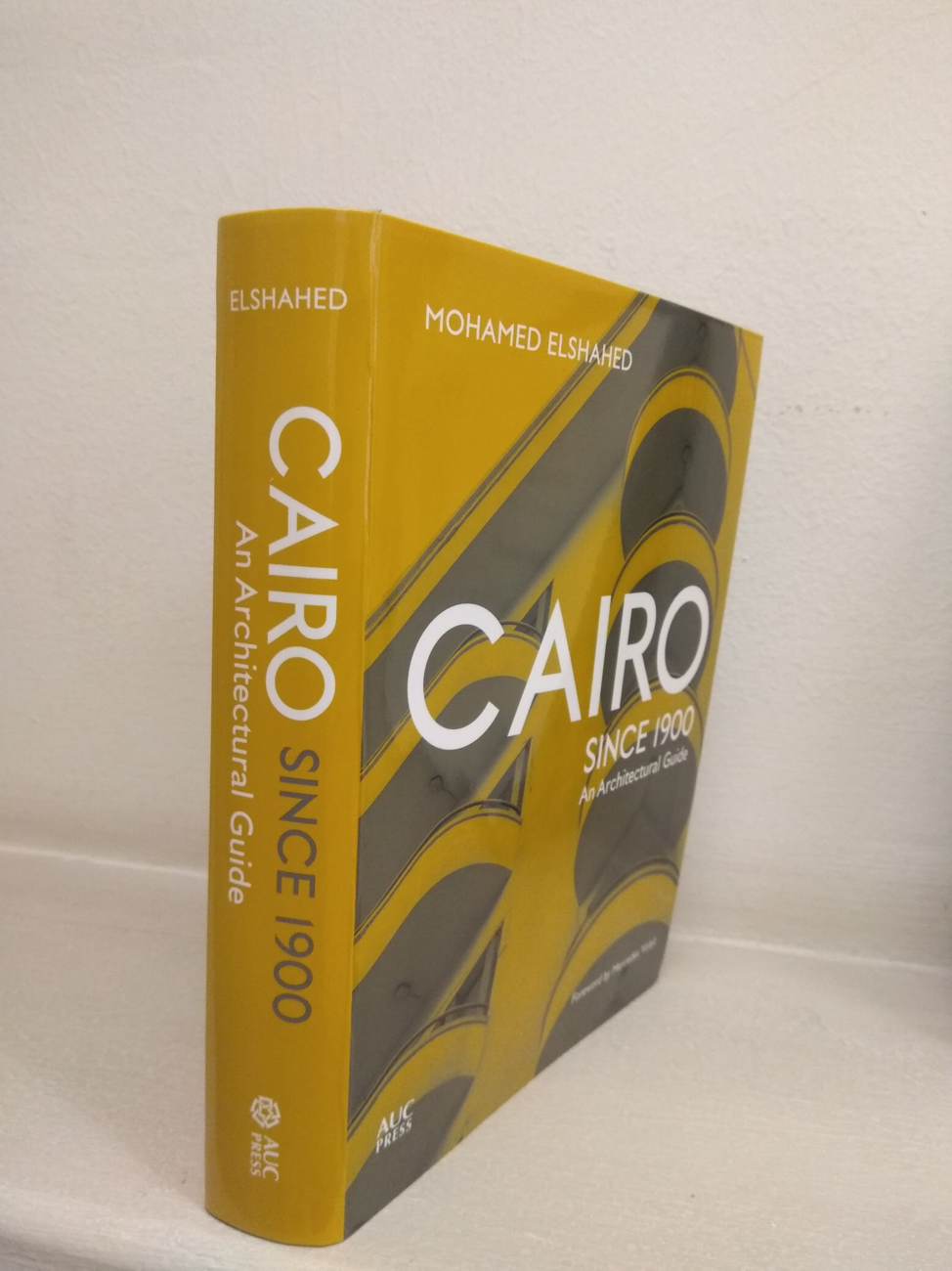
Cairo Since 1900: Book Review and Interview with the Author | by Shaimaa S. Ashour
Mohamed Elshahed, Cairo Since 1900: An Architectural Guide, (New York: The American University in Cairo Press, January 2020), 410 pp. | ISBN 9789774168697 . | $39.95.
Roots of the idea and sources of inspirations
In 2002, I became interested in Egyptian nineteenth and twentieth-century architecture. When I started looking for books on this topic, I found very few. The oldest was Muhammad Hammad’s book Misr Tabni (Egypt is Building or Egyptian Buildings) (1963) in Arabic. Then by the 1980s , five books were published; two in Arabic by Tawfiq Abd al-Gawwad: ʻAmaliqat al-ʻimarah fī al-qarn al-ʻishrin (Pioneer Architects in the 20th Century), Misr: Al-‘imara Fi-l- Qarn Al-‘ishrin (Egypt: The Architecture in the 20th century), two in French by Mercedes Volait: Al-‘imara: et Le Debat Architectural en Egypte dans Les Anees 1940 – 1960 (Al-’imara / The Architecture and the Architectural Debate in Egypt, 1940-1960), and L’Architecture Moderne En Egypte et La Revue Al’Imara, (1939-1959) (Modern Architecture in Egypt and Al-’Imara Magazine (1939-59)), and one in German by Mohamed Scharabi: Kairo: Stadt und Architektur im Zeitalter des Europaischen Kolonialismus (Cairo: City and Architecture in the Age of European Colonialism).
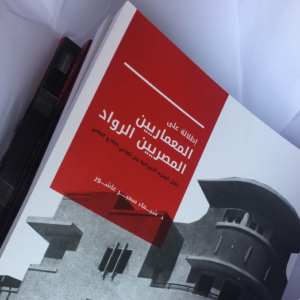 Thirty years after Scharabi, I published my book Al-m’mariiyn Al-misriiyn Al-ruwwad Khilal Al-fatrat Al-liybiraliah Bayn Thawratay 1919 wi 1952 (The Pioneer Egyptian Architects during the Liberal Era (1919-1952)) in Arabic. The first edition was published in 2011, as part of the book series Safhat min Tarikh Masr (Pages from Egyptian History) by the Madboly Publishing House, while the second edition was self-published in 2017. My book provides an overview of Egyptian architecture during three decades, starting with Egypt’s 1919 independence and ending with the 1952 revolution. The book has a special focus on the works of two architects: Antoine Selim Nahas and Aly Labib Gabr, and it consists of a deep study of the impact of political, economic, and socio-cultural factors on the local Egyptian ideology and architecture of that era. I cannot review Mohamed ElShahed’s Cairo since 1900: An Architectural Guide without comparing it to all the previously mentioned books. Hammad was presenting architecture of his own lifetime while Scharabi was interested in a certain period, style and area. Volait’s and my own book cannot be classified as architectural guides, but rather as in-depth comprehensive historical books synthesizing many contextual details.
Thirty years after Scharabi, I published my book Al-m’mariiyn Al-misriiyn Al-ruwwad Khilal Al-fatrat Al-liybiraliah Bayn Thawratay 1919 wi 1952 (The Pioneer Egyptian Architects during the Liberal Era (1919-1952)) in Arabic. The first edition was published in 2011, as part of the book series Safhat min Tarikh Masr (Pages from Egyptian History) by the Madboly Publishing House, while the second edition was self-published in 2017. My book provides an overview of Egyptian architecture during three decades, starting with Egypt’s 1919 independence and ending with the 1952 revolution. The book has a special focus on the works of two architects: Antoine Selim Nahas and Aly Labib Gabr, and it consists of a deep study of the impact of political, economic, and socio-cultural factors on the local Egyptian ideology and architecture of that era. I cannot review Mohamed ElShahed’s Cairo since 1900: An Architectural Guide without comparing it to all the previously mentioned books. Hammad was presenting architecture of his own lifetime while Scharabi was interested in a certain period, style and area. Volait’s and my own book cannot be classified as architectural guides, but rather as in-depth comprehensive historical books synthesizing many contextual details.
Cairo since 1900 is the first architectural guide to Cairo’s modern architecture and in a refreshing approach, buildings are not presented chronologically but geographically. In an interview I conducted with him in [December, 2019] Mohamed Elshahed explains the reason behind this choice: “we experience the city as a geographical location, not as time-travelling. Thus, buildings are presented in each district geographically as if I am ‘guiding’ the reader along Cairo’s streets.” One century of modern architecture is narrated through a selection of buildings outside how we normally classify Cairo’s architecture by districts, or styles or according to building scale, typology, or era. Initially, Elshahed did not focus on the much studied districts of Downtown, Zamalek, and Garden City. Rather, he extended the scope of the guide to include more than fifteen districts; this includes areas that are often overlooked, like Sayeda Zeinab, Daher and Nasr City. Since Downtown is the largest district in the area, it has the largest number of buildings in the guide. Even there, Elshahed does not classify the buildings according to their style, explaining, “this guide does not focus on a certain social class or European influences. Thus, buildings are not identified as styles but rather presented as tectonic composition; each had a certain statement or point of view that was developed through a process. Art approaches cannot suit architecture anymore.” When the author mentions art approaches, he is referencing the fact that art approaches run into two major obstacles when used to study architectural history: first, a majority of buildings in the city do not come from purely one particular style, but are rather a product of multiple styles, thus any attempt to classify the architectural history of the city into sequential styles is difficult without gross oversimplification, second, architecture is not like an art form with a single creator; in Egypt, architecture and engineering are overlapping fields. Many buildings are a product of both fields, and in some cases, civil engineering played a much more important role than architectural concerns. For instance, in the guide on Saint Mark’s Coptic Cathedral, Elshahed mentions civil engineer Michel Bakhoum as well as architects Awad Kamel Fahmy and Selim Kamel Fahmy. Moreover, in more than 15 buildings, the architect is completely unknown, like the two iconic buildings Ahram Beverages Company and École Alliance Israélite Universelle.
Elshahed also explores how wider ideological preferences may bias the viewer against the city’s more modern architecture. Specifically, he points out how the colonial perspective and nationalist responses to colonialism may result in the branding of modern architecture as ugly buildings. Not only here in Egypt, but worldwide, we equate between modernism and ugliness with the ultimate result that the demolition of those buildings does not strike us as a significant loss. In contrast, Elshahed argues that we need to alter aesthetic judgment to include 20th century architecture.
Elshahed believes that the discourse on the city and its architecture should be based on wider societal participation and engagement.This can be achieved by promoting awareness of modern architecture through a user-friendly guide. Thus, his target readers are students, locals and tourists. This can be seen, first, in the size of the volume, meant to fit into a pocket. Second, abstracted maps of districts with specific buildings identified facilitates self-guided walks. Self-guided tours are also made easier through scanning a QR code to cairosince1900.com/go*, where the reader can enter a building number as listed in the guide to be taken to its GPS location on Google Maps. Third, a glossary defining architectural terminologies from the Cairene perspective provides newcomers with an introduction to key terms. Elshahed explains further: “I cannot speak about brutalism in Cairo without mentioning Sayed Karim.” In all, this guide is suitable for a broad audience; it is not too technical, nor too simplified and anyone can easily access the information they need to enjoy Cairo’s architectural legacies.
Stars in the shadow
“I started working on the guide in 2015/2016 with a team of 10-15 for field surveying. The working plan started with one year to identify buildings, aiming not to start from already published sources rather starting from the street directly. Six months later, I started writing. This guide took three or four noncontinuous years, it would have taken half the time if the information were accessible and the streets were friendly.”
Here, Elshahed points out two important problems: a lack of information and the difficulty of street surveys. Nevertheless, Elshahed and his team have exceeded expectations, providing a wealth of information on various topics despite harsh street conditions with buildings continuously changing and the difficulty of taking photos.
The book must also be praised for its design; it is a combination of neatly reproduced plans, mixing photos with advertisements and concise essays. Elshahed mentions that more than double the number of plans that were reproduced were excluded from final publication. The plans of the buildings do need to be larger in size as many scholars need those conventions. The guide is also indexed with side titles, thus easily orienting the reader. Finally the guide’s cover is a photo for Waqf Gamalian Buildings: the Gamalian, as the guide tell us “with its distinctive streamlined modern lines, circular balconies cantilevered at the corners, and its immense scale…is an unmatched landmark in Cairo” (53). I wonder if there is any relation between the yellow color of the cover and Cairo’s dust?
Flipping Through the Guide
The guide starts with a historical introduction on building modern Cairo, starting in 1900 through the present. It is divided chronologically into three periods, each ranging from 40 to 50 years. In this section, Elshahed weaves together historical events, the ideology of each period, and significant architects working in this period with precedents of modern architecture. This introduction is followed by a maps section for all districts in the same scale. Cairo is a difficult city to draw or translate into map form. Thus, in some districts, buildings are spread and in others they are condensed, like Abbasiya versus Downtown. This is mainly because of the changing names of the streets between official maps, Google maps and local, unofficial names.
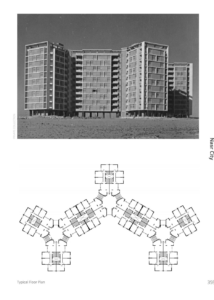 The guide originally intended to include 600 buildings then downsized to 226 buildings and sites of note. Each entry starts with basic information: address, GPS, year and architect. It is then followed by concise, explanatory text describing the building and its significance accompanied by photographs and conventions. This was done in a non-typical representation context suitable for each case. It is worth mentioning that building descriptions are as faithful to the original design as possible, with notes regarding major alterations or changes that have happened over the years. Elshahed explains the logic behind this choice: he says architecture is a dream. The best ideas happen in dreams or the concept stage, not in execution. Architecture changes in the implementation process, especially in Egypt. For instance, Sayed Kareem designed one or two-story podium in many housing models containing daycare facilities, stores, a cinema, a clinic, and other services, as well as a sculptural roof garden above the building; however, neither podium nor roof garden was implemented. As another example, in the initial design, the tower of the State Council was imagined “as a curtain-walled twenty-story block, but it was implemented shorter, with a regular grid of windows” (222).
The guide originally intended to include 600 buildings then downsized to 226 buildings and sites of note. Each entry starts with basic information: address, GPS, year and architect. It is then followed by concise, explanatory text describing the building and its significance accompanied by photographs and conventions. This was done in a non-typical representation context suitable for each case. It is worth mentioning that building descriptions are as faithful to the original design as possible, with notes regarding major alterations or changes that have happened over the years. Elshahed explains the logic behind this choice: he says architecture is a dream. The best ideas happen in dreams or the concept stage, not in execution. Architecture changes in the implementation process, especially in Egypt. For instance, Sayed Kareem designed one or two-story podium in many housing models containing daycare facilities, stores, a cinema, a clinic, and other services, as well as a sculptural roof garden above the building; however, neither podium nor roof garden was implemented. As another example, in the initial design, the tower of the State Council was imagined “as a curtain-walled twenty-story block, but it was implemented shorter, with a regular grid of windows” (222).
Regarding latter alterations in a building’s architecture, Elshahed is well aware of the fact that there was no system of preservation for modern buildings; they may change any time, so a building’s description in 2015 may differ drastically from its description in 2019. Thus, per Elshahed’s example, it is better to describe the original and hint at changes.
As for his criteria for which buildings to focus on, Elshahed explains:
“This is not the project of my selections or even selecting the best of [Cairo]; my aim is to highlight representative samples produced through the twentieth century. Not necessarily masterpieces, a category that often shapes the selection of buildings for guides like this. It is material evidence of the evolution of the city; they are partly the result of the aesthetic decisions made by the architects and their patrons, but also the result of economic, political, cultural, and municipal conditions impacting the time and place of their construction. But the last decision of selection was shaped by archival sources and available data.” (23-25)
He also gives pointers to help the students conducting the survey, asking them not to search for the architecture they already knew, but rather, expecting them to discover the unknown. He sees architecture as a product of political, economic, and cultural factors, not as good or ugly aesthetically. Even if unfinished,a building tells us something about a place. Have a look at all the churches chosen in the guide, most of them have unconventional design. Take a look at All Saints Cathedral, Virgin Mary Church (Al-Maraashli church), or the church of the college of the de la Salle school. Another example is Al-Halabi Print House, “(also known as al-Maimuniya) specialized in printing and publishing historical Islamic texts, as well as the Qur’an. It was the largest print facility of its kind in the region, with international distribution reaching East Asia and West Africa, and a printing capacity in the 1940s of seven million books a year” (297). The U-shaped, two-story, concrete building comprises a non-Islamic style, opposing the expected.
Wide uncommon diversity in typologies and time periods
Elshahed includes samples exemplifying typical and canonical trends as well as specimens expressing unique formulas. Some of the works reviewed are just proposals like the Islamic Congress Secretariat or Expo City, while others are unfinished, like the 1952 Revolution Museum. He also includes demolished buildings, as well as standing buildings like the AUC Science Building. In the guide, we find everything from bridges to gardens, from iconic buildings to unknown residential buildings with a story to be told. This broad range does not come at the price of detail. For instance, the Exhibition Grounds (now the Opera Grounds) and Opera House are not condensed and treated as one entity, but are detailed as two separate structures. This range extends across chronological barriers too, with buildings from different eras detailed side-by-side in the book. All are important to complete the image of the potential of a certain locale.
Worth mentioning here are the details Elshahed includes about the amount of time taken to build each structure; such details provide historical context and convey much about the building process. For instance, the High Court, originally designed for the city’s mixed tribunals, was the result of an international competition, with winners announced in 1924. While construction started in 1925, the building process was slow and faced delays, pushing its inauguration back to 1934. Had the author just mentioned that the building was opened in 1934, a story of ten years would have been erased: the building’s importance to the 1919 revolution, the construction process that stopped twice, first, for financial reasons when costs greatly exceeded the budget and second, due to construction problems. Another example is the 1952 Revolution Museum originally built in 1951 by the palace to function as a rest house and a dock for the royal yacht:
“The building was never used for its original purpose, due to the abrupt end of the reign of King Farouk. Subsequently, the officers used it as their Revolutionary Command Centre. In 2003 construction work commenced to implement designs by Ahmed Mito to transform the building into a museum. The renovation saw the construction of steel ribs in the shape of a bird taking flight, representing the Eagle of the Republic, above the roof of the otherwise Neo-Classical edifice.” (265)
Thus, it was built in 1951, redesigned in 2009, and is expected to open by 2020.
I would like to conclude by providing a few interesting stories from the guide and from my interactions with the author.
In the interview I conducted with him, Elshahed was able to provide greater insight about his engagement with the buildings he skillfully covered in his guide. It was quite obvious when I asked Elshahed about his top five buildings from the guide, he mentioned the Al-Azhar University Campus, Housing Model 33, Villa Sayed Karim, Abusir House 2 and Al-Kateb Hospital. Actually, I guessed two out of the five: Housing Model 33 and Villa Sayed Karim. I think Sayed Karim is a mentor for Elshahed. Initially, you can read it between the lines in Cairobserver, then, sayed Karim pictured at the beginning of the guide followed by photo for the main stairs at Villa Sayed Karim. Last, more than 40 buildings in the guide were designed by sayed Karim, that made him on top of index of architects at the end of the guide.
As I mentioned, the guide is full of interesting stories. Here is one of them about the Merryland Apartments: “The Merryland Apartments were partially realized twice, first in Heliopolis and again in Maadi. At the Heliopolis site, the unbuilt cylindrical block would have included eight three-bedroom apartments per floor. This block was implemented in the Maadi iteration of the project. The long, slightly curved middle block contains thirty duplexes every two floors, and the twenty-story tower houses twelve three-bedroom apartments per floor. The tower was not implemented in the Maadi version” (330).
In an otherwise flawless volume, one minor correction should be noted. On spotted lapse, the caption of the photo on p. 32 notes the names of two architects, (Gabr and Fahmy) incorrectly. The correct caption should read: “Architectural conferences and symposia took place regularly in Cairo, particularly in the period following the end of the Second World War. A group photograph from 1949 at an architectural gathering shows (from left to right) architect Ali Labib Gabr, English town planner (Greater London Plan of 1944) Sir Leslie Patrick Abercrombie, Mustafa Fahmy and his wife, Ahmed Sedky, and Abdulmoneim Heikal.”
Overall, this impressive guide is one of the endless possibilities of guides that could be written about Cairo in that period. Its aim is not to declare that these are the 226 buildings to be preserved, but rather to better understand how to read the city through them.
This essay is based on reviewing the book and an interview with the author, Mohamed ElShahed, in December 2019.
*Stay tuned, the site will be active soon.
Shaimaa S. Ashour is an architect with multi-disciplinary interests ranging from Egyptian 19th and 20th century architecture to cultural heritage, architectural advertisement and urban history. She is an assistant professor at Arab Academy for Science, Technology & Maritime Transport.
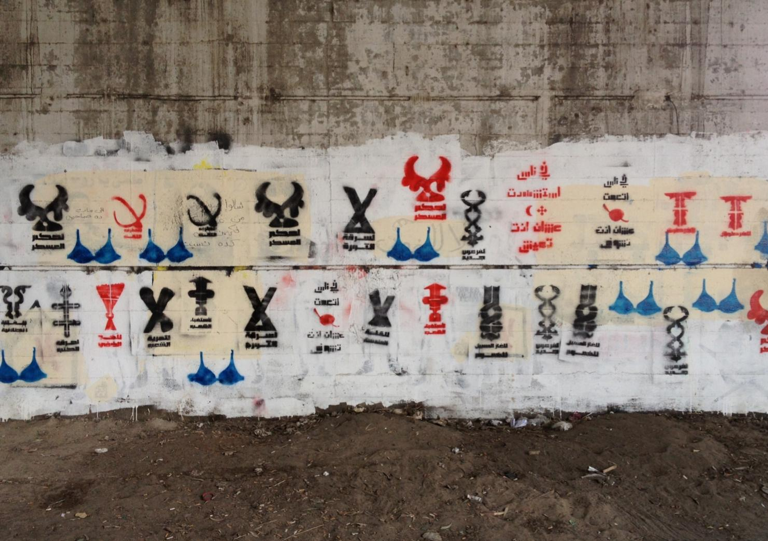
Art as Education: Street Art as a Precursor to Social Change | by Marwa Gadallah
Encounter between Artist and Observer
A revolution does not merely constitute a crowd of dissenters that stand against the prevailing order. It comes alive when a structured network is put in place and acted upon. Then, as visual artist, activist, and academic Bahia Shehab writes, “…we need to find our rightful place within this revolutionary structure.” In this structure, there is the protester, there is the journalist and the photographer, there is the artist and the poet, and there is the writer and the blogger. A single street artist, for instance, derives her artwork’s subject matter from the roles of others within the structured network. Her immediate surroundings, including the chanting protestors, can all contribute to the message that her artwork will proclaim. Then, just as these events are the context from which the artwork is born, the artwork, too, becomes a context from which other players within the revolutionary structure derive their own role. With work spanning the globe and several genres of visual art, including Arabic calligraphy, Bahia designs this context through her wall paintings, which she creates on streets in various parts of the world. In this process of meaning-making, what may be overlooked is the context or environment that is created while the artwork is actually coming to life. This involves the encounter between the working street artist and the passersby or the volunteer painters. This article explores the contours of this encounter and specifically asks how this encounter becomes an opportunity for education and social change.
A Thousand Times “No” on the Streets of Cairo
Bahia’s 2010 installation “A Thousand Times No” involved documenting the development of the letterform of the Arabic “lam-alif,” which translates into “no.” She later made use of the context of the Egyptian revolution of 2011 to display these various “no’s” on the walls of Cairo’s streets (Figure 1). She protested against and said “no” to such phenomena as violence, the stripping of protesters and the burning of books. Today, however, people are torn between their need for sociopolitical change and their need for a more stable life where their everyday needs are met in peace without the turmoil that a revolution brings about.
Mahmoud Darwish and the Inaccessible Dream
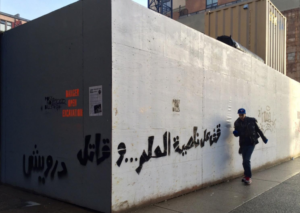
The more she studied and participated in the world of street art, the more Bahia began to notice a culturally diverse yet universal application of the artform. Beyond her “no” paintings, Bahia found new Arabic messages in the poetry of Mahmoud Darwish that were relevant to an international context and the state of the world at that moment. As a designer, she ensured that her Arabic calligraphic styles were relevant to a more modern audience. As such, much of her artwork employs letterforms that are inspired by simple geometric shapes. In Vancouver, Canada, she painted her first message from Darwish, which translates into, “Stand at the corner of a dream and fight” (Figure 2). This simple Arabic message is relevant even in Vancouver, since the idea of pursuing dreams has become a general matter of interest around the world. As
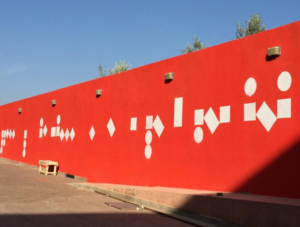
she was working on the piece, she noticed many people doing drugs on the street – a poignant reminder of the relevance of Darwish’s message and the importance of pursuing a dream and fighting for it even during such difficult times.
In Marrakesh, Morocco, the context of an Arab world filled with poverty and the sheer incapacity to make a living on the one hand, and the large number of young people who are ready to work on the other, inspired Bahia to paint Darwish’s, “We love life – if only we had access to it,” in the city’s streets (Figure 3).
Street Art, Mobilization and Acceptance of the “Other”
Street art does not only last for a period of time to give passersby the opportunity to see and understand its message but the nature of its environment allows even the creation process to become a learning experience for those participating in its creation. In Madison, Wisconsin, for instance, Bahia painted, “No to the impossible,”in Arabic alongside a team of film producers, students, professional muralists and an army veteran, all from diverse ethnic backgrounds (Figure 4). Th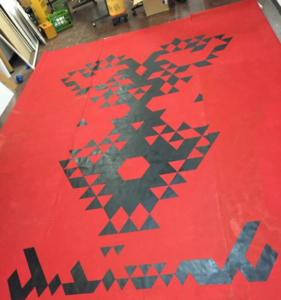 e fact that these very different people were gathered to create a painting with a common message that encourages persistence despite obstacles created an air of belonging among those present. This is such that one of the volunteer painters made the comment, “Teamwork makes dream work,” upon solving an issue with the piece, which is quite in line with the idea of the message, “No to the impossible.” This sense of belonging created by Bahia’s artistic environment encouraged members of the team to share their stories with each other, allowing an opportunity to hear and learn from people of different walks of life. To reconnect this idea to our opening focus on the impact of this type of street art, we can see in this experience how the creative process mobilizes the artist and the immediate audience to work towards the common goal of conveying the message of social change. It also allows people who are very different from one another to accept the “Other” in that moment of shared purpose.
e fact that these very different people were gathered to create a painting with a common message that encourages persistence despite obstacles created an air of belonging among those present. This is such that one of the volunteer painters made the comment, “Teamwork makes dream work,” upon solving an issue with the piece, which is quite in line with the idea of the message, “No to the impossible.” This sense of belonging created by Bahia’s artistic environment encouraged members of the team to share their stories with each other, allowing an opportunity to hear and learn from people of different walks of life. To reconnect this idea to our opening focus on the impact of this type of street art, we can see in this experience how the creative process mobilizes the artist and the immediate audience to work towards the common goal of conveying the message of social change. It also allows people who are very different from one another to accept the “Other” in that moment of shared purpose.
This mobilization process is als
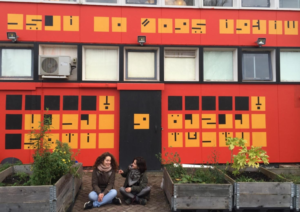
o quite evident in Bahia’s work in Amsterdam where she painted in Arabic a line from Darwish’s poetry that read, “One day we will be who we want to be. The journey has not started and the road has not ended” (Figure 5). The volunteers who worked on painting the wall alongside Bahia included archaeologists and university students who were from diverse cultures and backgrounds. Two of them spoke with Bahia about their opinions regarding Brexit and were in support of unity. Here, a perfect example of intercultural exchange is portrayed: An Arab artist speaks about Brexit with young Europeans.
Cross-Cultural Comparisons
In Cephalonia, an island which lies on the Ionian Sea, a part of the Mediterranean Sea, the dangerous journeys of refugees across the waters of the Mediterranean served as the context for Bahia’s artwork. The wall painting, which was created at an Olympicswimming pool in a sports complex (Figure 6), read in Arabic, “Those who have no land have no sea.” The letterforms were designed in the shape

of sailboats in honour of those who made the perilous trips by sea in order to escape their war-torn countries and, in many cases, died along the way. As she was working on the artwork, an opportunity for cross-cultural communication presented itself when a curious swimmer came up to ask her about her work. When Bahia learned that he was training for the Olympics, she was able to draw on her own background as an Arab and her concern for Arab issues to notice the deep contrast between the refugees fighting the waters in search for a safer home and the fact that the waters were flowing in this young swimmer’s favour, allowing him the chance to compete and get ahead in life.
Cross-Cultural Interaction and Educational Experiences
Through her artwork, Bahia has also managed to encourage Arabs to interact with others in European countries in light of their Arab culture. In Stavanger, Norway, she painted the phrase, “How big is the idea, how small is the state” (Figures 7 and 8). As she was painting the wall, she also spoke with many people around her. Among these was a woman named Mary who lived in the building overlooking the wall that Bahia was painting. Mary asked Bahia to paint another corner of the wall so that she could see a well-designed wall when she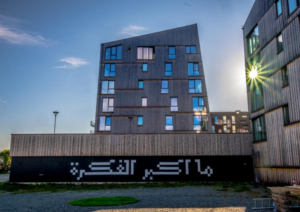 looked out of her window. Another Arab woman, a young Syrian Muslim named Amal, thanked Bahia for painting in Arabic in her neighbourhood and for encouraging the idea that not all Arabs are terrorists. Later, Bahia was shown a photo of Syrian students translating the words of her artwork to their non-Arab colleagues in a process of cross-cultural interaction. As such, Bahia’s work creates the necessary environment that encourages this form of educational experience. It also creates an environment of awareness that combats the racism and discrimination that is often unjustly directed at Arabs.
looked out of her window. Another Arab woman, a young Syrian Muslim named Amal, thanked Bahia for painting in Arabic in her neighbourhood and for encouraging the idea that not all Arabs are terrorists. Later, Bahia was shown a photo of Syrian students translating the words of her artwork to their non-Arab colleagues in a process of cross-cultural interaction. As such, Bahia’s work creates the necessary environment that encourages this form of educational experience. It also creates an environment of awareness that combats the racism and discrimination that is often unjustly directed at Arabs.
Cross-Cultural Hostility
Oftentimes, however, cross-cultural communication may be met with hostility in the form of racism. This is what Bahia encountered in Paris, France as she worked on a wall where she painted the words, “I will dream,” in Arabic (Figure 9). Just as the environments that Bahia creates while she works on her walls can foster positive forms of cross-cultural communication and education, they may also en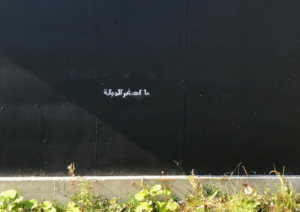 courage hostility, the very thing that they are meant to stand against. This is because these created environments cannot be stripped of the greater context in which they are born. In this case, the context is the prevailing air of racism that continues to linger on the streets of Paris. As she worked on the wall with her friend, several people responded to the Arabic writing on the wall in a racist manner, emphasizing an air of cross-cultural hostility. However, the positive aspect here lies in the fact that the creation process helped to further highlight the racism, which could later encourage a dialogue and, perhaps, even change.
courage hostility, the very thing that they are meant to stand against. This is because these created environments cannot be stripped of the greater context in which they are born. In this case, the context is the prevailing air of racism that continues to linger on the streets of Paris. As she worked on the wall with her friend, several people responded to the Arabic writing on the wall in a racist manner, emphasizing an air of cross-cultural hostility. However, the positive aspect here lies in the fact that the creation process helped to further highlight the racism, which could later encourage a dialogue and, perhaps, even change.
An Arab Artist’s Effort to Create Involvement and Ownership
As demonstrated, street art has the ability to create an environment that involves people in the immediate community and encourage them to play a more participatory role. This, in turn, encourages them to truly own the walls of the space in which they live. What is more interest
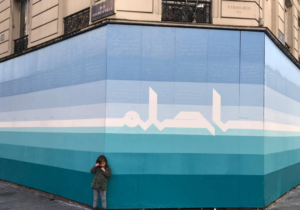
ing is how this may be done in a cross-cultural setting where an Arab artist facilitates this process of interaction and ownership for people who live in spaces that are foreign to her.
Art as a Precursor to Social Change
For social change to occur, there must be a beginning from which the fruit may grow. Today, in a world that is still overcast by racism, discrimination and violence, practical social change is not likely to occur in a smooth and peaceful manner. For social change to flourish, we must first engage in a process of education that allows us to understand the nature of our situation and acknowledge the problems and then better understand how we can address these problems. Bahia’s active engagement with the community through the environments that she is creating provides a basis for the cross-cultural dialogue that will encourage people to begin to think.
Marwa Gadallah is a graphic designer who is based in Cairo, Egypt. She is also a graduate of the Graphic Design program at the American University in Cairo. Her graduation project was on disseminating the socially and politically charged concept of Orientalism as presented in Edward Said’s book using a combination of visual and textual elements to a young Egyptian audience. She is also venturing into the field of political cartooning where her interest in visualizing social and political topics lies. She has also done design work for the finance sector. Some of her work can be viewed through this link: https://www.behance.net/marwa-gadallah.
Image Captions: 1– “No’s” sprayed on a wall, Bahia Shehab, Cairo, Egypt ; 2– “Stand at the corner of a dream and fight”, Eyoälha Baker, Vancouver, Canada ; 3– “We love life – if only we had access to it”, Yousséf Belbahri Achir, Marrakesh, Morocco; 4– “No to the impossible”, Bahia Shehab, Madison, Wisconsin; 5–“One day we will be who we want to be. The journey has not started and the road has not ended”, Bahia Shehab, Amsterdam, the Netherlands; 6–“Those who have no land have no sea”, Ghalia Elsrakbi, Cephalonia; 7– “How big is the idea, how small is the state”, Brian Tallman, Stavanger, Norway; 8– “How small is the state”, Brian Tallman, Stavanger, Norway; 9–“I will dream”, Arullan, Paris, France.
Citations
Shehab, B. (2009). At the Corner of a Dream. London: Gingko.
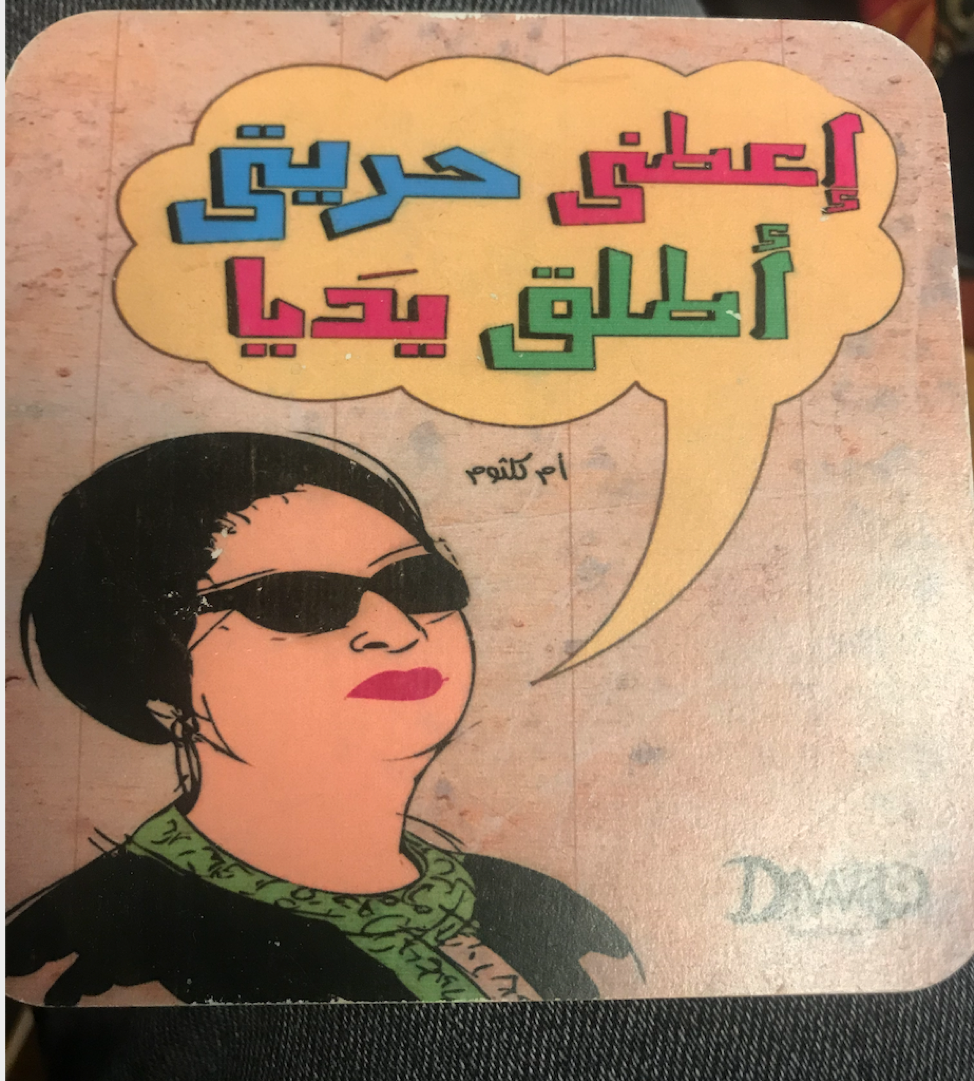
Umm Kulthum Conquers all: Kawkab al-Sharq through Pop Art | by N.A. Mansour
When it comes to the great divas of Arabic song, there’s this saying: you listen to Fairuz in the morning, to Umm Kulthum at night. I didn’t use to subscribe to that notion, even though I had seen plenty of people indeed blast Fairuz in the morning and Umm Kulthum at night. But in all my obstinance, I rejected it straight off, even as a child. Instead, I believed that the world was really divided into two types of people: Umm Kulthum people and Fairuz people. I was born a Fairuz kind of woman. Afterall, a true mutriba, Umm Kulthum sang long ballads running up to 40 minutes long in a husky voice my impatient ear hesitated to call beautiful. Fairuz’s voice was like silk and had a haunting lilt reminiscent of tajwid, the art of Qur’anic recitation I was being taught in primary school. Besides, al Sitt, Umm Kulthum was Egyptian; I am not.
There were other whispers in my ear, telling me I was a Fairuz kind of woman and not Umm Kulthum’s. I grew up in a world where the trivial was to be avoided. My homeland was at war, so fantasy novels were to be kept to a minimum. We would not watch movies at the cinema and instead wait for the home release. Food was never to be wasted, every sesame seed swept from the table and deposited into our mouths. But Fairuz was alright because she sang for our cause: for Jerusalem and with it, all of Palestine. I was thus allowed – by my father and my society – to fall backwards into her eclectic canon, from Ya Bint Shalabiyya to the funky al-Bostah, which hearkened back to provincial life with its lyrics laden with gossip but did so to a beat I learned to later call ‘funk’. In my memory, Fairuz is the sound of my small Palestinian village in the early 2000s. I carried her with me across the world, into college and beyond. I bought a long-sleeved t-shirt with Fairuz’s face on it the year I lived in Jordan, post-college. I bought the shirt from one of those boutiques that mixes identity politics and pop art, because I was nostalgic for the person I had been throughout college: in love with pop culture and not afraid to show that love in its most blatant form. But that person was changing. I was slowly morphing into an academic, into someone who aspired to belong to the intellectual class. I wanted my aspirations to be taken seriously; these are the anxieties of a woman who studies her own culture. So I did not wear the shirt and it eventually went to live in my storage locker, where it still is today. Instead, I wore riding boots with dark jeans and floral tops. This was the uniform of an academic, I told myself.
At graduate school, I still didn’t listen to Umm Kulthum. Instead, I dove into the rich oeuvre of post-Arab Spring Arabic rock. I traveled everywhere but Egypt because I believed – and I still believe to some extent – that Egypt should be de-centered in narratives of the Middle East and North Africa. Egypt’s sheer cultural output cannot be disputed, but I wondered of the damages of that narrative. Umm Kulthum loomed large in my mind as a symbol of that scale, with those epicly long songs and with the detail she expected from every production (and from herself). I had been given a postcard of her at an exhibition of Egyptian film posters. I begrudgingly framed it with other pop-culture memorabilia, a student’s alternative to buying art. I fawned even more over the Abdul Halim Hafez postcard I had received at the same event; my friends and I had swooned over him in our teens, the unattainable dark nightingale. He made sense to me, while Umm Kulthum still did not. I held onto him, Fairuz, and Arabic rock as signifiers of who I was, even as I became more firmly labeled in my self-image as an intellectual and as an elite. It’s what happens to people who want to be historians. I quietly lamented the loss of that young girl who belonged to a village community and wasn’t afraid to show her allegiances through her choices in dress and her angry emboldened voice, but I also knew this was who I had always aspired to be. I would not admit it, but I was torn between who I wanted to be, who I was raised to be, and who I was.
I went to Egypt to do dissertation research because it was deemed necessary by the institutions and structures which envelope me, in order to check it off the list of things historians of Islam must do; you have to write about Egypt in some measure if you’re writing about the Arabic-speaking world. I maintained it would be a quick trip: I would be in and then out. I am, after all, a creature of small lush country towns, not a city person, not a desert person. I would not like it, I thought, just as I had always been averse to Umm Kulthum. But something softened within me when I arrived in Cairo. The world was less black and white. I asked questions instead of jumping to conclusions and slowly, inexplicably I fell in love with Umm Kulthum and she began to tackle the tensions I felt within myself, one by one.
I began recognizing her lyrics – that’s how I knew it was beginning. The lyrics would come to my mind when speaking. I’d be telling someone, for instance, how expensive something was and ya aghla min hayati, you who is more valuable than my life, would almost make it to my lips. I would hum the melodies too, especially the long instrumentals that prelude her vocals. Especially those. I asked cab drivers to raise the volume when she came on and we would hum together, bonded for a few moments. I walked, then ran to her catalogue, exploring a long career that burned brightest in the years immediately prior to her death: my favorites remained the classics Alf Layla wa Layla and Inta Omri. The process was complete: I had been conquered by al Sitt, kawkab al-sharq, the diva, Umm Kulthum.
I bought a necklace with the title lyrics from Inta Omri at a boutique in downtown Cairo that no longer exists. It was in the shape of a hand, reminiscent of amulets meant to ward off different maladies. Casting Umm Kulthum as an amulet appealed to me. Not only was it a marriage between two different forms of popular culture, but I felt it meant she protected me; some twisted form of thawab. The songs were a bit like that, too. Like the Qur’an, but to a far lesser extent: if I listened to them, I could not go astray.
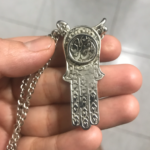 I left Egypt soon after realizing the extent of my love for Umm Kulthum. I kept the amulet around my neck and her songs in my ears. I still fought against romanticizing al Sitt; romanticizing Umm Kulthum, like romanticizing Cairo, could only do damage to the rest of the Arab world. The rest of us have stories; we create art that is innovative and charming and we have ideas.
I left Egypt soon after realizing the extent of my love for Umm Kulthum. I kept the amulet around my neck and her songs in my ears. I still fought against romanticizing al Sitt; romanticizing Umm Kulthum, like romanticizing Cairo, could only do damage to the rest of the Arab world. The rest of us have stories; we create art that is innovative and charming and we have ideas.
Cairo and Egypt were not and should not be al-qahira, the conquerer and arbiter of taste who loomed above all, mostly above the Arabic-speaking world. But I could not ignore how Umm Kulthum, beyond her voice, connected us to one another – anyone who identified culturally with her that is. Even as someone who is multicultural, multiracial, and multilingual, I do believe some connections can not be made with peoples of other backgrounds; try as hard as we might, lines of race, culture, religion, and economy cannot always be crossed. But where there is al Sitt, I began to realize, I could cross some lines that were otherwise impenetrable, aided in some ways by the language I speak, the fabric I wear on my head and my dark eyes. When in Egypt, I could admit to Egyptians that she was the best and begin a conversation that way. Our woes would come out through her lyrics. So could our joy. I had not been able to do that with Fairuz.
The people who pushed back against these notions of Umm Kulthum supremacy were elites, mostly academics. If you asked them, young people do not listen to Umm Kulthum. They commented on the pop art: the t-shirts, the necklaces, the coasters evoking Umm Kulthum. They told me this was a sure sign her star had fallen: this was pop art, popular because it was kitschy, not because of who it represented. Young people enjoy tokens to show who they want to be on their sleeves; it does not reflect who they are. Pop art is elitist. I’m sure these academics would have said the same thing of my Fairuz t-shirt from way back when.
To some extent, they’re right. The Umm Kulthum socks I bought a friend cost a pretty penny. The coaster I keep on my desk did not, but it symbolized elite culture all the same: a Cairene bookstore made them and bookstores can wear an elite glow that discourages people that do not belong. Coasters themselves are an elite idea, if you scrunch your eyes up slightly and take a step back. There are traps set around elitism and privilege and they are traps that are meant to correct, to move us towards a more equal society. I fall into those traps daily. But some forms of culture correct us. They remind us that the venues we privilege, the way we engage other human beings, and the cultures we can share all have consequences. My Umm Kulthum coaster reminds me of that, as it sits on my desk, Umm Kulthum’s face partly obscured by my tea cup. It’s also a reminder to switch to my Umm Kulthum playlist.
Sometimes, instead, the coaster also reminds me to switch to my Cairokee playlist, blatantly one of my favorite bands. Something of the woman who loved Fairuz because she crossed boundaries, blending funk and debke, loves the band for the same reason. They blend sha’abi, rock, hip-hop and more. The Egyptian people agree with me: their Kan Lak Ma’aya was the most popular song in Egypt the summer of 2019. It is this track I switch to when reminded by my coaster and with good reason: al Sitt lends the title lyric here and Cairokee sampled a lyric of her classic Ansak ya Salam. I listen to it when I’m writing my dissertation and I grin when I hear it in downtown Cairo booming out a microbus. Listening to it, even when not listening to Umm Kulthum directly, I submit to al Sitt, she who creeps into everything and makes it her own, she who will outlive me and does more than I – a wannabe intellectual – ever could for my homes and my peoples.
N.A. Mansour is a PhD candidate at Princeton University’s Department of Near Eastern Studies, where she is writing a dissertation on the transition between manuscript and print in Arabic-contexts. Her interests include Islamic studies, Arabic-language pop culture, and food.
Captions for Images: 1- Fairuz on a Graphic T-shirt (Photo Credit:JoBedu); 2- Umm Kulthum, 3- An amulet-style necklace featuring the lyrics of Umm Kulthum (Photo credit: N.A. Mansour).
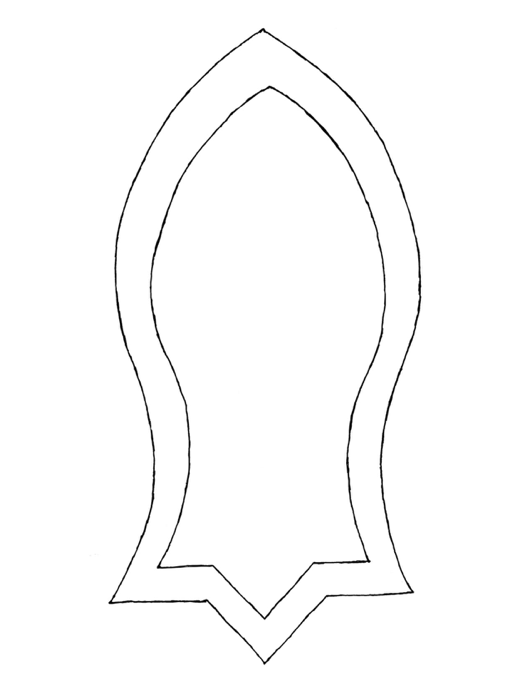
Athar and the Boundless Multiplication of Relics | by Richard McGregor
The analytical model of popular versus elite culture seems to have outlived its usefulness, but perhaps some of what that model was trying to describe may be reclaimed and reframed in useful ways. Even if the structure of this binary is too loaded with assumptions about power and privilege, some of the phenomena it sought to represent nevertheless remain with us. I’m thinking here more specifically of the sense of uncontrolled multiplication of human culture; that is to say, human practices, ideas, and artifacts, which proliferate in unbounded but not random ways. This is the idea of a decentering and scattering of cultural agency, which was surely part of what the term “popular culture” was referencing.
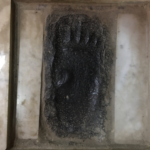 It is this sense that drives the Islamic concept of athar (pl. āthār), whose most basic meaning is imprint or marker. The semantics of the term also have a temporal range, as in a ‘trace’ or ‘footprint’, both of which connect the present moment with the past. Hence an athar may be a material relic, serving as a tactile or visual bridge, or an oral tradition (hadith), a report passed down from the earliest days of Islam. Like footprints in the sand, which leave information for those who are attentive to them, both relics and hadith reports connect an evolving present to a sacred past.
It is this sense that drives the Islamic concept of athar (pl. āthār), whose most basic meaning is imprint or marker. The semantics of the term also have a temporal range, as in a ‘trace’ or ‘footprint’, both of which connect the present moment with the past. Hence an athar may be a material relic, serving as a tactile or visual bridge, or an oral tradition (hadith), a report passed down from the earliest days of Islam. Like footprints in the sand, which leave information for those who are attentive to them, both relics and hadith reports connect an evolving present to a sacred past.
Recalling the sense I evoked earlier of uncontrolled multiplication of religious culture, the connection between reports and relics is redoubled. Collecting, transmitting, and assessing hadith – and likewise the display, preservation, and provenance of relics – must seek in part to control the boundaries of such expressions. Not every object can be a relic, and not everything put forward as the words of the Prophet or his companions can be canonized as tradition. Thus, athar is both a continuity (an inheritance, a remainder) and a bounded or conditional proliferation.
Contacts and Impressions
One type of relic, rather evenly distributed across the medieval religious landscape, was that of clothing. Various personal items, including pieces of the Prophet’s shirt, were preserved in Cairo, many ultimately being housed at the Husayn shrine. The mantle and turban of the great saint Ahmad al-Badawi (d. 674/1276) are still displayed next to his tomb in Tanta. Medieval accounts make note of these objects, and their veneration. Footwear is another type of clothing with a long history as a relic. The earliest example on record – although one that seems to have had limited appeal – was the slippers of the Fatimid caliph al-Mansur (d. 341/953). His son cherished the Imam’s slippers and passed them down so later generations might benefit from the baraka.
Holy footprints made several appearances on the devotional landscape of Mamluk Cairo. A set of important relics may be found at the tomb of Sultan Qa’itbay (d. 901/1496). Lying in the northern Qarafa cemetery, the sultan’s mosque and funerary complex houses two foot imprints in stone. One is attributed to the Prophet (figure 1) and the other to Abraham. The late seventeenth-century traveler al-Nabulusi visited the site twice, and described inscribed domes of silver and copper installed over the relics. The pious pilgrim recited from the Qur’an, and added supplicatory du‘a prayers while he kissed the imprints. The relics were so prized that even from the afterlife, Sultan Qa’itbay himself would jealously guard them. After a visit to the relics, the Ottoman Sultan Ahmad reportedly had them transferred to Istanbul. Later in a dream, in which Qa’itbay argued his case before the prophet Muhammad, it was made clear to the Ottoman Sultan that the relics must be returned to their rightful place in Cairo.[1]
Objects and Images
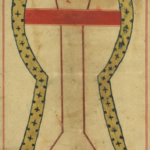 For narratives concerning the veneration of similar sandals, we move to Damascus. The Ayyubid ruler al-Malik Ashraf was particularly fond of this kind of relic. In 625/1228 he had a sandal relic installed in his newly completed madrasa, the Dar al-Hadith al-Ashrafiyya. This was not the only sandal in town however, and twelve years later the Madrasa Dammaghiyya would be founded, containing another sandal. Although Ashraf’s relic would be looted by the invading Turco-Mongol Tamerlane in 803/1401, it enjoyed a great deal of attention in the interim. An Andalusian traveler visiting the Ashrafiyya in 648/1285 mentioned the relic was housed in a niche to the left of the mihrab, with various texts of the Qur’an stored in a niche to the right. We are told that:
For narratives concerning the veneration of similar sandals, we move to Damascus. The Ayyubid ruler al-Malik Ashraf was particularly fond of this kind of relic. In 625/1228 he had a sandal relic installed in his newly completed madrasa, the Dar al-Hadith al-Ashrafiyya. This was not the only sandal in town however, and twelve years later the Madrasa Dammaghiyya would be founded, containing another sandal. Although Ashraf’s relic would be looted by the invading Turco-Mongol Tamerlane in 803/1401, it enjoyed a great deal of attention in the interim. An Andalusian traveler visiting the Ashrafiyya in 648/1285 mentioned the relic was housed in a niche to the left of the mihrab, with various texts of the Qur’an stored in a niche to the right. We are told that:
“The door of the niche was made of gold-colored brass, with three silken drapes (khilal) – green, red and yellow – hanging from it. The sandal rested in a special box made of ebony and held together by silver nails. A salaried custodian was in charge of displaying the sandal to the public twice a week – on Mondays and Thursdays. Visitors used to touch it, in the hope of acquiring some of its baraka.” [2]
Ashraf touted its virtues, and encouraged others to visit and gaze upon it. It could also go on the road; Ashraf had it sent to Ba’albek so that an elderly admirer could visit it. This was the grandmother of the historian al-Yunini who recorded the episode with pride in his Dhayl mir’at al-zaman. We do not have details on its transport or display, but perhaps portable reliquary practices were more common than we might think. Ashraf’s devotion to the relic endured to the end of his life. A report has come down from 635/1237, the year of his death, which describes him in the madrasa, taking the sandal in his hands, kissing it, placing it upon his eyes, and weeping. The prince left little doubt as to his own devotion to the object, and by implication the piety of the entire institution, which as a center for the study of hadith was a fitting place to store, display, and venerate the relic.
Ashraf had first come into contact with the relic thanks to Ibn al-Hadid – from a Damascene family well-known for their commerce in relics – who ceremonially introduced the relic to Ashraf, at which point he bared his head, and in joyful tears began to kiss the precious object and rub it against his face. A later traveler from the mid-fourteenth century describes the relic further in situ. He tells us there were two niches on the qibla wall of the madrasa. The one to the right of the mihrab contained copies of the Qur’an, while the one to the left housed the noble sandal. The sandal rested upon a stand, and its outline would be engraved upon an ebony tablet, which could be sprinkled with perfume and transferred to any devotee who kissed the outline of the sandal. Devotees visited the site on Mondays and Thursdays, when the relic was displayed and tracings could be made.
Although it disappeared with the onslaught of Tamerlane at the end of the fourteenth century, the ritual power of this relic had been well established. In addition to the madrasa centered veneration, it enjoyed a high-profile career in public protests. In 711/1312, when the merchants of Damascus were joined by the religious class in public demonstrations against the oppressive local governor, the Prophet’s shoe was brought out of the Ashrafiyya college. A mass of protestors assembled. Led by the preacher of the Umayyad mosque, Jalal al-Din al-Qaziruni, and carrying aloft the flags of the mosque, the ‘Uthmanic codex, and the sandal, the protestors marched together to confront the governor. Their protest however, was not well received. Jalal al-Din was violently arrested and dragged to the governor’s palace, while the sandal and the codex were thrown to the ground. News of this unrest alone was probably enough to get the governor dismissed, but for Muhammad ibn Qala’un, the Sultan back in Cairo, the insult to the codex and the sandal was unforgiveable, and he had the governor publicly humiliated and thrown in jail.
Making Pious Copies
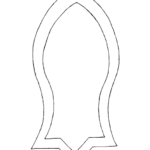 As a miraculous relic, the sandal could be enlisted to help with personal afflictions beyond the political. An individual crisis would presumably have been behind many pilgrims’ visits to the Ashrafiyya sandal. But significantly, a rendering of the sandal could perform these services equally well. Stylized representations were copied one from the other in the thirteenth century, handed down along with their chains of transmitters, to guarantee their authenticity much as hadith reports from the Prophet and his companions were transmitted. [3] The great hadith commentator, al-Qastallani (d. 923/1517) repeated claims that tracings of the sandal would bring blessings to its owners, safeguard them from sedition, the machinations of their enemies, and the malevolence of the devil or the evil eye.
As a miraculous relic, the sandal could be enlisted to help with personal afflictions beyond the political. An individual crisis would presumably have been behind many pilgrims’ visits to the Ashrafiyya sandal. But significantly, a rendering of the sandal could perform these services equally well. Stylized representations were copied one from the other in the thirteenth century, handed down along with their chains of transmitters, to guarantee their authenticity much as hadith reports from the Prophet and his companions were transmitted. [3] The great hadith commentator, al-Qastallani (d. 923/1517) repeated claims that tracings of the sandal would bring blessings to its owners, safeguard them from sedition, the machinations of their enemies, and the malevolence of the devil or the evil eye.
The historian Ibn ‘Asakir describes a tracing of the sandal being placed on the site of pain on a suffering woman’s body, with miraculous results ensuing. These traced relics proliferated within Islamic book culture, appearing alongside poems and devotional descriptions of Muhammad and his virtues, all the while serving as tactile and tangible sites of relic interaction for its readers. Thus, these illustrations themselves became active relics. One modern scholar, Josef Meri, has noted how the tracing of the sandal in a manuscript copy of Ibn ‘Asakir’s work has been almost worn away by readers touching the image.
Another example, this one from the seventeenth century (figure 2), is typical, showing an embellished outline, along with the two leather straps. Often the straps are indicated simply by two circles, representing the holes made to hold them, which Muhammad used to secure the sandals to his feet. Al-Tirmidhi’s al-Shama’il al-Muhammadiyya provides details on the Prophet’s sandals, quoting material from the hadith and other early accounts. Despite the embellishments and stylized appearance, the precise dimensions of the tracing are crucial. As long as the dimensions are preserved, a limitless number of true copies can be generated.
The boundaries of this athar are only limited by the number of hands that take up the project of relic reproduction. A tracing made in 1848 – reproduced here by the Damascene scholar Issam Eido ( figure 3 )– consists of a thin double line. The contents of the book in which it appears make clear that despite its stylized reduction, the relic fully retains its power to deter misfortune. In this case of reproduction, the tracing appears in an eighteenth-century commentary on a seventeenth-century commentary on the famous panegyric poem Dala’il al-khayrat by the fifteen-century Sufi poet al-Jazuli. In this example, the line of reproductions spans from the fifteenth to the twenty-first century. In a 1901 printed copy, Yusuf al-Nabahani guarantees the accuracy of his copy by reassuring his reader that it has been photographically reproduced from an earlier seventeenth-century rendering in a book by al-Maqqari. Although al-Nabahani’s relic-as-tracing is mass produced, its miraculous and curative efficacy is not reduced.
With the sandal relic, we encounter a scattering that occurs through practices of tracing. The outline of the relic is far more than a shorthand or a symbol. Rather than being a lesser copy of an original, the tracings are fully the relic, and we are told they apparently wield the baraka that the sandal would. In this, such renderings resist our prevailing conception of the sign and its distant signified. Tracings offer a connection to an absent original, but just as importantly they constitute it within the limitless moments that subsequently make up the inheritance – or the athar – that is the relic. This expanded notion of relic allows us to see that the tracings are not only the original as it lives through history, but also fully particular, specific and hence limited. It is in this sense that the tracing relics capture the power of their original but also walk out the infinite but structured possibilities that will constitute the future of the relic. Although al-Malik al-Ashraf would not have thought of it in these terms – through its copies the relic extends its presence, and is scattered infinitely. To him, and perhaps more sensibly than anything historians of religion can say, the boundless multiplication of the sandal simply confirms the relic’s miraculous power.
Richard McGregor is Associate Professor of Religion and Islamic Studies at Vanderbilt University. Professor McGregor’s area of expertise is Islam, particularly the medieval intellectual and mystical traditions. He explores religion at the intersections of philosophy, theology, aesthetics, and embodiment. His work has received support from the Fulbright Program, the American Academy of Religion, the American Research Center in Egypt, the Getty Foundation, the National German Research Foundation, the French Ministry of National Education, and the Social Sciences & Humanities Research Council of Canada. He received his PhD from McGill University in 2001, and at Vanderbilt teaches courses on Qur’an and Interpretation, Sufism, and Method and theory in the Study of Religion. His forthcoming book is titled Islam and the Devotional Subject: Seeing Religion in Egypt and Syria (Cambridge University Press, 2020)
Captions for Images: Fig 1, Footprints at Qa’itbay’s tomb. Photo by author, 2019. ; Fig 2, “The Prophet’s Sandal” 1628. From ms These Are the Virtues of the Tracing of the Prophet’s Sandal (Hadhihi siffa timthal na‘l al-Nabi) by Ahmad ibn Muhammad Abi Bakr al-Fariqi al-Qadiri. The National Library of Israel Ms. Yah. Ar. 353.; Fig 3, Issam Eido “Sandal Tracing by Issam Eido, 2019” 2019, Nashville TN. From tracing by Abd al-Qadir Habbal (fl 1848) in Sulayman ibn ‘Umar Jamal, Kitab al-minah al-ilahiyya bi-sharh Dala’il al-khayrat ms 130 fols, 170 x 120 mm, 27 lines. Held by University of Michigan. Digital copy, Hathi Trust online record 006782286.
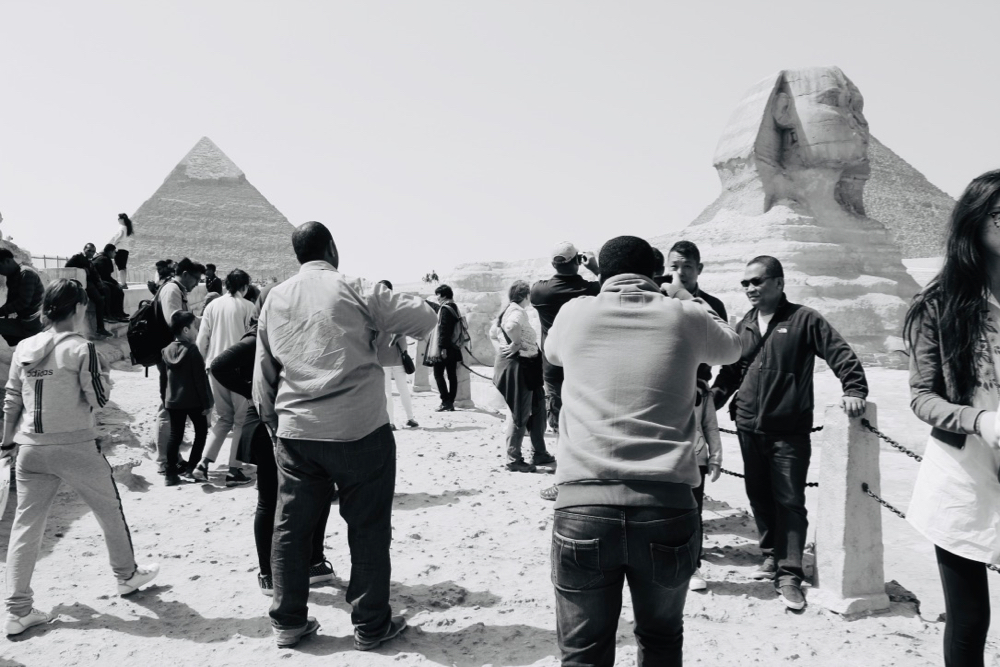
The Price of Popularity - What option do conservators, site managers, and the general public have when our heritage is increasingly seen as the domain of the elite?| by Sally El Sabbahy
In the spring of 2012 I was sitting in a dimly lit coffee shop at the tip of Zamalek interviewing a 30-something Egyptologist that had found himself thrust into the international spotlight. He, like many younger Egyptians, had turned to social media to draw attention to the undercurrents and events that official media outlets and foreign newspaper headlines were overlooking or had not yet deemed newsworthy. But his cause wasn’t political: he was urgently and desperately trying to document and publicize the looting of Egyptian antiquities, sounding the alarm on a coming cultural tragedy of incomprehensible proportion.
The conversation was emotional, punctuated by long periods of heavy silence as he collected and recollected himself in between answers. The ‘what,’ ‘how,’ and ‘who’ of the topic were overwhelmingly complex. The profile of looters stretched from opportunistic teenagers to well-funded archaeologists; the methods included everything from haphazard pit-digging in the desert to the unnervingly premeditated theft of museum objects. The targeting did not discriminate either, because while pharaonic objects and monuments were the hardest hit, medieval and early modern artifacts were also aggressively lifted from monuments and storage magazines across the country. In the midst of this insurmountable and devastating chaos, the only easy answer was the ‘why.’
You wouldn’t be wrong for assuming the reason behind the looting and savaging of Egypt’s cultural objects and monuments was financially driven. A lot of people made a great deal of money by selling out their country’s historic relics. But dismissing this tragedy in Egypt’s modern history as the consequence of an innate greed tucked away in every human, simply waiting for the rule of law to collapse so it can be unleashed, is not a pragmatic response. The truth is a lot more uncomfortable and nuanced. For many Egyptians, our heritage has never been our own. Its value has long been linked with its ability to attract foreign visitors and currencies, and consequently the rights and necessity of Egyptians to consume or engage with their cultural heritage has always been secondary to that of the ‘other.’
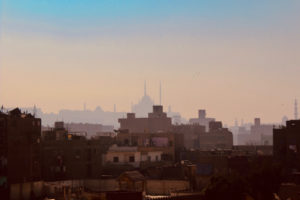 I’ve seen this manifest in endless ways, both as a child growing up in Egypt, and now as a young professional working in the heritage field. From witnessing school-aged children being refused entry into a medieval period home-turned-museum, to being personally turned away at the Citadel of Salah El-Din because only foreign tourists are permitted to drive up its considerably steep entrance, to listening to community members living around a World Heritage Site recall how they were given mere days to vacate their ancestral family homes for demolition because they were suddenly deemed at odds with what a historic landscape should ‘look’ like.
I’ve seen this manifest in endless ways, both as a child growing up in Egypt, and now as a young professional working in the heritage field. From witnessing school-aged children being refused entry into a medieval period home-turned-museum, to being personally turned away at the Citadel of Salah El-Din because only foreign tourists are permitted to drive up its considerably steep entrance, to listening to community members living around a World Heritage Site recall how they were given mere days to vacate their ancestral family homes for demolition because they were suddenly deemed at odds with what a historic landscape should ‘look’ like.
The specter of our recent inheritance of the management and care of our own heritage from the British (and before that, the French) in the 1950s is a difficult one to banish. The priorities of colonial antiquities management fell squarely into the realm of what we now recognize as long-term, institutionalized looting, and the romance of the explorer period has been dulled by the realization that much of Egypt’s history was ripped away from it for the glory and wealth of Europeans. What was left in Egypt was put on display in museums designed for foreigners and the social elite, accompanied by labels in English and French, and rarely Arabic; and as time went on, monuments that had been conserved were locked away behind iron gates in an attempt to freeze them in time as our cities evolved and shot up around them.
Modernizing a Historic Problem
For reasons that are deserving of their own dissertation and that I will not go into here, we’ve had a very hard time shaking off the institutional vestiges of these racist and elitist policies and practices, having instead largely adapted them into our local administrative systems and social hierarchies. And if this self-imposed ‘othering’ is pervasive enough to tarnish so many of my early memories and current experiences – effectively penetrating the forcefield of my privilege as the offspring of two respected heritage professionals – then what must it feel like to those without similar social signifiers?
Back in 2012, the teary-eyed Egyptologist clutching a now cold cup of coffee already had an answer to that question. He recalled how in the midst of the ransacking of a storage magazine late one night, he grabbed a young man about to run off with a pharaonic statue and begged him to put the object down and walk away. He attempted to reason with him, telling him this was his heritage, that he was hurting himself and all of us by looting. As the young man’s friends gathered around to watch, he yanked his elbow out of the Egyptologist’s grasp and retorted that antiquities belonged to the government, not to the people. This would not be the last time that he, nor many of us that have come to work in the field since, would hear this rhetoric or experience something like it.
For those that were paying attention, the aftermath of 2011 on Egypt’s heritage was perhaps dismally inevitable, but it was a wake-up call all the same. Long-simmering issues, centered on the lack of access – physically, informationally, and socially – for Egyptians to their historic monuments and objects had erupted in a painful and devastating way that we will never genuinely recover from. Catalyzed by 2011 and the years that followed, a number of local groups were founded that focus on community outreach, with an emphasis on storytelling, conservation, urban solutions, architecture, and education. They have made impressive headway with bridging the gap between living communities and the remnants of our past, particularly in Historic Cairo; a sprawling World Heritage Site that houses a significant number of medieval monuments and serves as an ideal, if challenging, urban laboratory primed for such initiatives.
The main objective of these groups, if it could be distilled, is increased social development – with heritage preservation serving as a very solid springboard. The equation is relatively simple: show people the benefits that can come from our heritage and teach them the value of it, and they will be more likely to relate to it and want it protected. Initiatives like the ones in Historic Cairo are by no means overlooked. Their work is timely, their output and results tangible, and their methods proven. But their efforts focus on monuments and neighborhoods that are not (yet) deemed ‘en vogue’ by the tourism economy, and here is where our institutional management of certain types of heritage is again leading us down a problematic path of exclusion.
During the Symposium on Egyptian Popular Culture that took place at the American Research Center in Egypt (ARCE) in January 2020, a recurring topic was that of popular culture versus elite culture and the presence and function of so-called cultural gatekeepers: the institutions and influential figures that deride what is deemed vulgar or common-place culture and in the process of doing so, inevitably cordon off more ‘valuable’ cultural outputs so that they may be narrowly consumed by like-minded elites. These elites can include figures such as academics, artists, curators, wealthy classes, or the politically well-connected and placed. What then happens when heritage objects and monuments are categorized this way by our gatekeepers?
More Money, More Problems
The hard-to-banish specter of colonial social engineering to which I referred earlier has found a fresh body to inhabit in post-2011 Egypt: our tourism portfolio. After nearly a decade of suffering through a shattering tourism drought and creeping along the slow road to recovery, Egypt is now welcoming more tourists through its borders than at any other time in its modern history, thanks to improved national security and slick marketing campaigns. Our historic sites and spaces, trapped in a deteriorating maintenance and management limbo for years due to lack of funding and visitors, have suddenly been called to action to assist in getting our economy back on track. But while Egypt may be a bucket list destination for most able travelers, it still has a cash flow problem: much of the money spent by visitors traveling to Egypt is pocketed before they even arrive in the country, through all-inclusive deals and group travel packages that they book from their home countries.
The reason for this is two-fold: our tourism infrastructure is outdated and largely monopolized by ‘mass bus’ tourism operators that employ tightly curated itineraries meant to capture as much profit for themselves as possible. The other issue is that our cultural heritage tourism, while some of the finest in the world, has been so poorly maintained and outfitted over the last few decades that visitors often don’t spend enough time in a single location to inject some much-needed liquidity into the local economy (having meals at community-run restaurants and buying souvenirs from shops located off the tourism trail really does make a difference – remember this the next time you travel!). Relevant official institutions have begun to address these issues through a tourism reform program and by trying to improve and diversify Egypt’s cultural tourism attractions, however the sudden spotlight on our heritage and its integral link to our economic well-being has also kicked off something of a modern gold rush.
Consequently, our heritage objects and monuments that have featured the most heavily in popular culture references and media (and are therefore the most universally recognizable) – such as the pyramids of Giza, the mask and tomb of Tutankhamun, the mosque of Muhammad Ali, the Karnak Temple Complex, and much, much more – are being aggressively commodified in order to attract greater tourism revenue and appeal to higher caliber segments of our own population. Who is leading the charge in this? To put it bluntly, it’s not the people at the lower rungs of our institutional ladders that have the ability to decide if sphinxes will be moved from their historic location of origin to a busy urban square in the city center. They’re also not signing off on wedding parties between well-connected families taking place with limited oversight and regulation in historic temples. While it’s easy to get caught up in the myopic callousness of these decisions and events, our concerns should extend well beyond the implications of drunk wedding guests rubbing their hands on the wall reliefs at the Temple of Isis in Philae. These incidents are symptoms, and they shouldn’t distract us from the malady.
I recently consulted on a competitive bid for the management of a hotly anticipated museum opening in Egypt, and was charged with designing a sustainable governance model for the space. The exciting thing about this is that it was the first time I was consulting for a project involving an entirely new and purpose-built building, and I saw endless possibilities for environmental efficiency, social outreach and training exchanges, and developing a visitor experience that is as accessible to non-Egyptians as it is to Egyptians. However, the bidder, a privately-owned Egyptian investment company, had other things in mind.
They decided that their competitive edge would be to present a luxury museum experience, akin to that of an exclusive hotel. I was instructed to write in plans for a concierge service, cotton hand towels in every bathroom (merely logistically speaking, this boggles the mind), and devise a solution for how to train the Egyptian staff so that they wouldn’t ‘bother’ foreign visitors. When I suggested a free access day that could take place once a year (a standard practice in most large museums around the world), I was told that they would not be able to maintain the standard of the museum if they allowed for such things. While the experience was amusingly satirical in some ways, it alarmed me more than anything.
Open the newspaper and you’ll see that heritage is increasingly attracting private investors and policy makers, lured by the promise of long-term financial returns and the power and prestige of being stewards to the more marketable facets of our heritage. Further compounding this are the actions of private stakeholders, who instead of informing the public sector about appropriate and accessible museum or site management (via their proposals, for example), are instead selling pipe dreams of resort-like museums and historic landscapes that dangerously confuse cultural access and appreciation with elitism and exclusivity.
We’re socialized to believe that our gatekeepers are informed or educated ‘enough’ to know what they’re doing – that there is some larger wisdom driving decisions like these. But what if there isn’t? What if it’s about control, money, and association? Elites, whether they were foreign colonizers, or present-day domestic decision makers and well-connected business figures, are always seeking to draw lines in the sand about who should be able to access and commodify certain elements of our culture and how. Cultural heritage, especially when it’s as immensely valuable and universally recognizable as Egypt’s is, is a powerhouse. And unlike other more niche aspects of human culture, it is not something that we should ever allow to be divvied up and presented as exclusive to those in power. We have already learned the hard way how that ends the instant our elites lose their grip.
Discourse as Documentation
The Symposium on Egyptian Popular Culture was great for a lot of reasons: it was fun, there were excellent speakers and well-considered topics, and it’s not very often that we are allowed the opportunity to engage with so many influential and brilliant people at the same time and in the same space. What struck me most though was how much everyone wanted to connect, debate, challenge, and share with one another. Modern life can be hectic, Whatsapp is ever-present (and so easy), and the traffic is terrible – and because of that we often don’t really talk to one another. Or at least not long enough or to an engaged enough degree to achieve that tingly feeling our brain sends through our nervous system when we get excited because someone feels the exact same way – or not – as us about something.
But I saw this happen again and again at the symposium; the discussion periods often needed to extend well beyond their designated time slots, and speakers and attendees alike engaged in friendly skirmishes, agreeing and disagreeing about what constitutes popular culture and how it should be conserved, managed, and sustained for today and tomorrow.
The matter of cultural heritage inevitably came up, and was a designated topic on both days of the symposium. These conversations were immensely heartening to observe and participate in, as we discussed the potential of social media to popularize lesser known and appreciated objects and places, and our increasing and shared worry of the ‘museumification’ and excessive curation of our history in order for it to appeal to the elite and/or other, rather than function as a reflection of ourselves as Egyptians.
Policies are hard to change, elites may often lack incentive to listen, but what the rest of us can do is talk to one another. As you read this, you may have agreed or disagreed with some or all of what I said – and that’s the intention. I know I am only seeing a fraction of the reality on the ground; others will have seen more, experienced more, and can pick up where I leave off. That’s the beauty of human discourse: when we talk and share our informed opinions and experiences we contribute to what we and others know and we remain vigilant.
While this information may not empower us enough to change our cultural heritage policies right now so that our heritage is more equitably preserved and accessible, it can serve as a form of documentation for another time in the future when we can change things. Much like that inspiring and determined Egyptologist facing insurmountable challenges to photograph, tweet, and document the looting of our heritage, we need to see the value in sharing what we know, and most importantly, what we think. We may not recognize the usefulness of this now, but discourse and the sharing of information matters because it can eventually lead to solutions and innovations, and often, it tells us more than what even the best journalists end up publishing. As conservators, managers, and consumers of Egypt’s cultural heritage, we owe it to ourselves to keep talking to one another.
Sally El Sabbahy specializes in sustainable site and destination management solutions and has consulted on projects in Europe, the United Kingdom, and Egypt. A former journalist and longtime writer, she also oversees communications for a foreign cultural institute in Cairo.
*Image Captions: 1- Tourists rush to get a selfie at the Great Sphinx. 2- The skyline of historic Cairo, with the citadel visible in the background.
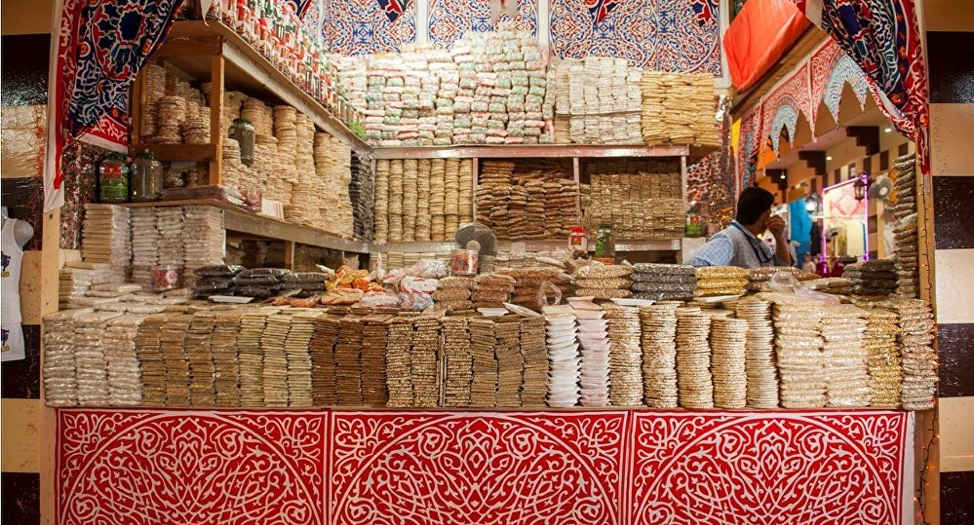
Is there more to the Mawlid al-Nabī Celebrations in Cairo than Candy and Cakes | by Ida Sofie Nitter
Since the Fatimid Caliphate (tenth-twelfth centuries CE), the mawlid al-Nabī, the birthday of the Prophet Muhammad, has been celebrated in Egypt. What started as an official court commemoration by the sultan has been transformed into a celebration that draws large crowds of Muslims together for religious celebrations and social gatherings.[1] For Sunni Muslims the celebration falls on the twelfth day of the Islamic month of Rabi’ al-Awwal (the 9th/ 10th of November in 2019). In Egypt, it is an official holiday, and thus many Egyptians have the day off. In Cairo, the celebration is marked by colorful decorations of the city, sweets, and the recitation of poems and songs in praise of the Prophet Muhammad. For many Cairenes the mawlid al-Nabī is marked by the special mawlid sweets sold both in supermarkets, bakeries, and most importantly, in brightly colored and lit pop-up shops all over the city. These shops are up for a few weeks to a month before the holiday and are frequently blasting ‘anāshīd sung in praise of the Prophet Muhammad.
Today, the most common sweets are caramelized nut and seed-based sweets. However, more traditionally the sweets sold in these mawlid stands have included “the bride” (al-‘arūsa) and “the horse” (al-ḥiṣān). The origin of these distinctive sugar-based Egyptian mawlid treats seem to date back to the Fatimid caliphate. There are many tales explaining the significance of the bride and a man on a horse (in some stories representing a soldier, in other a sultan), however, their exact origin and purpose remain mysterious. One of the more common explanations is that during a mawlid celebration the Fatimid caliph al-Ḥākim bi-‘Amr Allāh (d. 1021 CE) dressed up one of his wives in a white dress and with a flower crown and paraded with her on a horse through the city, and that it is this scene candy makers have been recreating ever since. Although the sweet shops still sell dolls during the weeks leading up to the celebration, nowadays these are often made of plastic. However, it is still possible to get the traditional sugar dolls and figures by visiting the Bāb al-Baḥr street in Islamic Cairo.
Even though for many Cairenes the festivities are mostly about the distinctive mawlid sweets, the celebration of the mawlid al-Nabī carries a lot of controversies reflecting religious debates in Egypt. For example, as the mawlid was approaching in November 2019, an acquaintance who knows I study Islamic history asked me if it is ḥarām (forbidden) to eat mawlid sweets, and where the `aḥādith (sayings of the Prophet Muhammad) in favor of this practice can be found. Unsurprisingly there are no `aḥādith specifically about eating sweets on the Prophet’s birthday; however, the underlying criticism in the question reflects larger debates on the validity of celebrating the day, where critics of the practice say it is a bida‘a, an innovation that goes against the teachings of Islam, and thus should not be celebrated.
One of the main reasons the celebration of the mawlid causes a lot of controversy in Egypt is the importance of this holiday to Sufis. For centuries, the day has been celebrated by members of Sufi orders (ṭuruq, s. ṭarīqa) by public parades through the cities accompanied by chants, drumming, poems, and songs in veneration of the Prophet Muhammad. In this parade, members of the Sufi orders carry banners, signs, or flags with the name of their order and they are thus very visible to bystanders. Additionally, in Cairo the ṭuruq used to have tents set up representing their order, where they distributed food to bystanders, sang ‘anāshīd, chanted adhkār, and generally engaged in devotional activities. Although the parade is nothing like what it was in years past, it still drew thousands of people in 2019 marching from Ṣāleh al-Ja’afarī mosque to the new headquarters of al-Azhar in the Gamaliyya district (video). The large tents of the past are mostly gone, though the Ba’alawi ṭarīqa had one set up during the 2019 mawlid celebrations spending the night of the twelfth of Rabi’ al-Awwal in praise of the Prophet outside masjid al-Ḥussayn. So, in many ways, the celebration of the mawlid al-Nabī is less colorful than it was in the past.
In the nineteenth century, the mawlid al-Nabī was one of the biggest annual public celebrations in Cairo, and it was the time when most Sufi ṭuruq were publicly visible.[2] These celebrations were organized and overseen by the Bakri family – who were also the head of the Khalwatiyya order in Cairo – as Muhammad ‘Ali, the Ottoman governor and ruler of Egypt, had given them authority over other Sufi orders and related institutions in 1812 to centralize control over Sufi activities in Egypt.[3] Additionally, the state was supporting the Bakri’s in their organization of the mawlid, providing money from the treasury for the celebrations. Similarly, the Cairo municipality provided rice, mutton, cooking butter, tea, and wood, and the Khedival estate delivered sugar and cooking utensils. The organization of the dates of the celebration of the mawlid – as it was a multi-day event – was also done in collaboration between the heads of the ṭuruq and the qadi (judge) of Cairo, which was then approved by the governor of Cairo.[4] Thus, the entire affair was a collaboration between the ṭuruq and the state. The ṭuruq then gathered in central Cairo at al-Bakri’s palace in al-Azbakiyya together with the heads of shrines and other religious figures and the khedival permit for the mawlid was read. The dates on which the various ṭuruq were expected to hold dhikr sessions and the timings for parades and processions were also announced. Princes, the ‘ulama (religious leaders), government ministers and officials were invited to a reception by the heads of the ṭuruq at al-Bakri’s palace. During this ceremony the leaders of the ṭuruq received robes of honor.[5] Then tents were erected in the area around the palace in al-Azbakiyya for the celebrations.
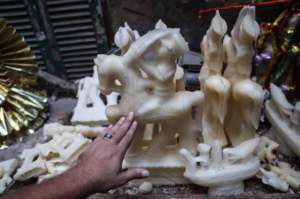 In the nineteenth century, the celebration of mawlid al-Nabī lasted for many days before its climactic ending on the 12th of Rabi’ al-Awwal. On this date two notable events took place. The first was the ritual of the dawsa, where the shaykh of the Sa’dīyya ṭariqa rode on horseback over a carpet covering men in the ṭariqa prostrating. Despite being stepped on by the horse, the men were seemingly unharmed by the ritual, and this thus was used to display the karāma (marvel) of the shaykh. The second notable event on the night of the 12th of Rabi’ al-Awwal was a final grand celebration where the khedive and his entourage as well as ministers, government officials, and other dignitaries attended the pavilion (ṣiwān) of al-Bakri and the Khalwati ṭariqa. Finally, the mawlid concluded with a state-sponsored firework display.[6]
In the nineteenth century, the celebration of mawlid al-Nabī lasted for many days before its climactic ending on the 12th of Rabi’ al-Awwal. On this date two notable events took place. The first was the ritual of the dawsa, where the shaykh of the Sa’dīyya ṭariqa rode on horseback over a carpet covering men in the ṭariqa prostrating. Despite being stepped on by the horse, the men were seemingly unharmed by the ritual, and this thus was used to display the karāma (marvel) of the shaykh. The second notable event on the night of the 12th of Rabi’ al-Awwal was a final grand celebration where the khedive and his entourage as well as ministers, government officials, and other dignitaries attended the pavilion (ṣiwān) of al-Bakri and the Khalwati ṭariqa. Finally, the mawlid concluded with a state-sponsored firework display.[6]
As I hinted at earlier, the state’s involvement with the Sufi ṭuruq’s celebration of the mawlid al-Nabī did not stop with its financial contributions. Rather, the end of the nineteenth and beginning of the twentieth centuries were marked by the enactment of several rules and regulations to help the state better control the activities of the Sufi ṭuruq. Thus, in 1881 ‘Abd al-Baqi al-Bakri was pressured by Khedive Tawfiq to pass rules regarding the ritual practices and structures of the ṭuruq.[7] In that same year, Khedive Tawfiq also passed a decree himself prohibiting the practice of the dawsa during the Mawlid al-Nabī and all other occasions.[8] What is interesting about this particular prohibition is that it seems to have been done under the pressure of the political and intellectual elite who were aware of and upset by the European condemnation of the practice.[9] To “civilize” or “clean-up” Sufi practices does indeed seem to have been one of the underlying incentives to the rules passed by ‘Abd al-Baqi al-Bakri in 1881 as seen by the following articles: “Art. 3: The use of the sword, the eating of live coal, serpents, glass, the striking of oneself with cannon-balls and the like in public processions or fairs are hereby strictly prohibited”; “Art. 6: No religious assemblies are to take place in the public thoroughfares but inside the houses of Sheikhs and their deputies and to be conducted with due reverence and respect”; “Art. 18: All ‘Zikrs’ at fairs etc, are to be conducted with due reverence and respect and in the presence of a duly authorized Sheikh. No unauthorized Sheikh can conduct a ‘Zikr’ and if he contravenes their injunction he shall be punished. Only prayers are to be recited but songs are prohibited.”[10]
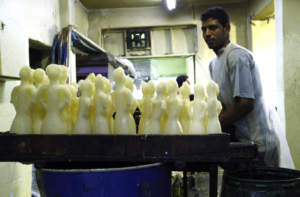 Up until the early twentieth century, the celebration of the mawlid al-Nabi was for both the public and the ruling class. In the nineteenth century the celebrations at al-Azbakiyya had a tent among the general festivities for the Khedive and other members of the ruling class where they would distribute food to the poor. The same was done in the early twentieth century at the celebrations in al-‘Abbāsiyya, where the King would take over the role of the Khedive.[11] In both cases, the state celebration of the mawlid al-Nabi took place among the popular celebration. However, more recently, state officials have stopped attending the popular mawlid celebrations and instead arrange their own much more formal ones: think of men sitting in rows in formal business attire listening to speeches by government representatives.
Up until the early twentieth century, the celebration of the mawlid al-Nabi was for both the public and the ruling class. In the nineteenth century the celebrations at al-Azbakiyya had a tent among the general festivities for the Khedive and other members of the ruling class where they would distribute food to the poor. The same was done in the early twentieth century at the celebrations in al-‘Abbāsiyya, where the King would take over the role of the Khedive.[11] In both cases, the state celebration of the mawlid al-Nabi took place among the popular celebration. However, more recently, state officials have stopped attending the popular mawlid celebrations and instead arrange their own much more formal ones: think of men sitting in rows in formal business attire listening to speeches by government representatives.
Although taṣawwuf has gained traction in some elite circles today, taṣawwuf in Egypt is often equated with lower class religious practices. However, this is only a development of the last century and a half. In the nineteenth century, individuals from all social and economic groups were members of ṭuruq. This is seen very clearly by the significant presence of the elite in orders such as the Wafā’īyya and the Demirdāshiyya. Furthermore, a popular assumption seems to be that the religious establishment, including the ‘ulamā’ at al-Azhar, are (and always have been) against practices associated with taṣawwuf, including the very existence of ṭuruq. This assumption too is historically incorrect. Whereas it is true that there has been an ongoing debate for centuries regarding permissible and impermissible acts associated with taṣawwuf, a significant number of the ‘ulamā’ in Egypt have been participants in Sufi orders. Although the connection between al-Azhar and Sufi ṭuruq has decreased over the last century, both Fredrick De Jong and Rachida Chih have demonstrated the existence of a strong link in the eighteenth and nineteenth centuries between Sufi orders – the Khalwatiyya order in particular – and the ‘ulamā’ and students of al-Azhar.
Although the religious practices and social significance of the mawlid al-Nabi in Cairo has decreased over the past century and a half, the media coverage of the mawlid also has significant impact on the perception of the mawlid. For example, as just mentioned, in the early twentieth century the public and state celebrations of the mawlid al-Nabi in Egypt were separated from one another. Thus, in contrast to the parade and celebrations in masājid, the government holds a much more sober celebration marked by speeches and men in suits. Although one can find information about both celebrations in online news-sources, printed newspapers hardly write about the parade of the Sufi ṭuruq and associated celebrations, whereas the formal state celebration receives plenty of attention and is also broadcast live on TV. This is a marked change from the media coverage of the early twentieth century, when newspapers focused both on the state officials and the public in their coverage of the mawlid.[12]
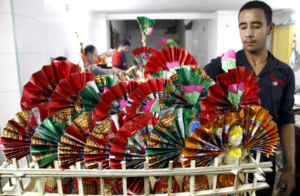 According to Samuli Schielke, these developments are indicative of a wider trend in modern Egypt, where the state has sanitized the mawlid through “selective representation and exclusion.”[13] It is unclear how much of this process is deliberate and how much is just a byproduct of separating state and popular mawlid celebrations; however, the result is striking. The lack of coverage is also true for the celebrations of mawālid of other prophets or saints, and Sufi religious gatherings and practices. Thus, purposefully or inadvertently, the process of “cleaning up” taṣawwuf and making it more “fit” for modern Egypt and the modern world, is a practice that has carried on from the time of khedives in the late nineteenth century to the present day.
According to Samuli Schielke, these developments are indicative of a wider trend in modern Egypt, where the state has sanitized the mawlid through “selective representation and exclusion.”[13] It is unclear how much of this process is deliberate and how much is just a byproduct of separating state and popular mawlid celebrations; however, the result is striking. The lack of coverage is also true for the celebrations of mawālid of other prophets or saints, and Sufi religious gatherings and practices. Thus, purposefully or inadvertently, the process of “cleaning up” taṣawwuf and making it more “fit” for modern Egypt and the modern world, is a practice that has carried on from the time of khedives in the late nineteenth century to the present day.
It is not only Egyptian media representations of the mawlid al-Nabī that are influencing the public imaginary of contemporary religious life in Egypt; Western academia is inadvertently doing the same. Even though taṣawwuf has been an integral part of religious life in Egypt in the modern era, few academic works – at least in English, there are more in French – have been published by major presses on the subject. However, some works should be mentioned: the French author Rachida Chih recently published Sufism in Ottoman Egypt: Circulation, Renewal and Authority in the Seventeenth and Eighteenth Centuries (2019), Catherine Mayeur-Jaouen has edited and translated her book Al-Sayyid al-Badawî, un grand saint de l’islam égyptien (1994) from French to English, under the title The Mulid of Al-Sayyid Al-Badawi of Tanta: Egypt’s Legendary Sufi Festival (2019). Regarding the nineteenth century, Frederick De Jong’s work Ṭuruq and Ṭuruq linked Institutions in Nineteenth Century Egypt (1978) remains one of the seminal texts on taṣawwuf. The anthropologists Valerie Hoffman and Samuli Schielke have both contributed to the literature on taṣawwuf as a living tradition in modern Egypt in their works Sufism, Mystics, and Saints in Modern Egypt (1995) and Snacks and Saints Mawlid Festivals and the Politics of Festivity, Piety and Modernity in Contemporary Egypt (2006). Yet, compared to the massive academic literature on modern Egypt these works are few and the accepted narratives on Egyptian history, life, and culture tend to be overpowered by authors focusing on other aspects of Egypt’s history. Thus, even though taṣawwuf plays a central role in the history of modern Egypt, it is often overlooked in academic discussions of Egypt.
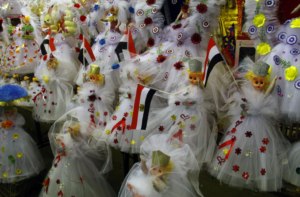 A striking example of just how the role of the mawlid al-Nabī has changed in the last two centuries may be found in Edward Lane’s An Account of the Manners and Customs of the Modern Egyptians. Describing the mawlid al-Nabī celebrations of 1834, Lane writes:
A striking example of just how the role of the mawlid al-Nabī has changed in the last two centuries may be found in Edward Lane’s An Account of the Manners and Customs of the Modern Egyptians. Describing the mawlid al-Nabī celebrations of 1834, Lane writes:
“The preparations for the festival are generally completed on the second day of the month; and on the following day the rejoicings and ceremonies begin: these continue, day and night, until the twelfth night of the month … [On the eleventh night] I passed on to a street called Sook El-Bekree, on the south of the Birket el-Ezbekeeyeh, to witness what I was informed would be the best of the zikrs that were to be performed.”[14]
Clearly the celebration that Lane witnessed was much more spectacular than the mawlid celebrations today. Although dhikr sessions still happen, they are mostly held in the privacy of peoples homes, in centers, or mosques, not as large gatherings on the streets. As shown in this piece, through purposeful and inadvertent actions made by rulers of the past and researchers and writers of the present, the mawlid al-Nabī in Cairo has for many been reduced to the mawlid sweets eaten during the holiday and detached from its religious history here in Cairo.
Ida Sofie Nitter is a PhD Candidate at the University of Pennsylvania. As an ARCE Research Associate she is currently living in Cairo and conducting her dissertation research. Her dissertation focuses on tasawwuf (Sufsm) in 19th century Cairo, and the religious practices associated with tasawwuf, including the celebration of mawlids, tomb visitation, the use of litanies, and studies with Sufi shoyoukh. Nitter is passionate about what religious practice and Islam looked like in Cairo in the early modern and modern period across social and economic divides. She hopes to provide a counterweight to the heavy focus on Islamic Modernism that has gained in Western academia’s study of modern Egyptian history.
*Image Captions: 1-A standard selection of mawlid sweets. © Sputnik. Ahmed Badr; 2- Undecorated sugar horse. (Photo: AFP); 3-Undecorated bride sugar dolls. Photo by Mai Shaheen; 4-Decorated sugar dolls. Photo by Mai Shaheen; 5- Plastic dolls are more and more common around Cairo in place of the traditional sugar dolls.. Photo by Mai Shaheen.
[1] Samuli Schielke, “Snacks and Saints: Mawlid Festivals and the Politics of Festivity, Piety and Modernity in Contemporary Egypt,” Dissertation, University of Amsterdam, 2006, p.164.
[2] Frederick De Jong, Turuq and Turuq-Linked Institutions in Nineteenth Century Egypt: A Historical Study in Organizational Dimensions of Islamic Mysticism, Leiden: Brill, 1978. p.61.
[3] Richard McGregor, “Is this the End of Medieval Sufism? Strategies of Transversal Affiliation in Ottoman Egypt,” In Le soufisme à l’époque ottomane: XVIe – XVIIIe siècle, Cairo: Institut français d’archéologie orientale, 2010, p. 89.
[4] De Jong, Turuq and Turuq-Linked Institutions in Nineteenth Century Egypt. p.61.
[5] De Jong, p.62.
[6] De Jong, p.63.
[7] De Jong, p.124.
[8] De Jong, p.96.
[9] De Jong, Turuq and Turuq-Linked Institutions, p. 96 and Schielke, “Snacks and Saints,” p.193.
[10] De Jong, pp.197-199.
[11] Schielke, “Snacks and Saints,” p.186.
[12] Schielke, p.186.
[13] Schielke, p.187.
[14] Edward William Lane, An Account of the Manners and Customs of the Modern Egyptians: The Definitive 1860 Edition, Cairo: American University in Cairo Press, 2003, pp.443-4.


